
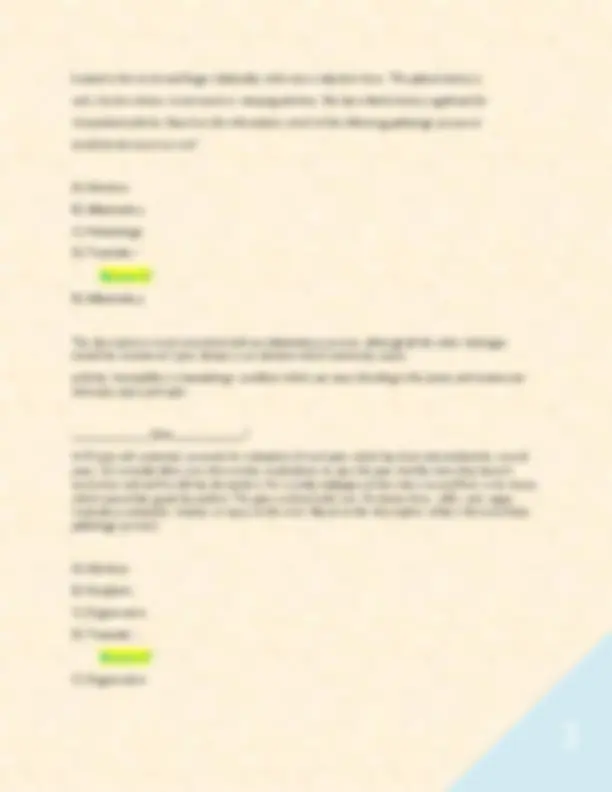
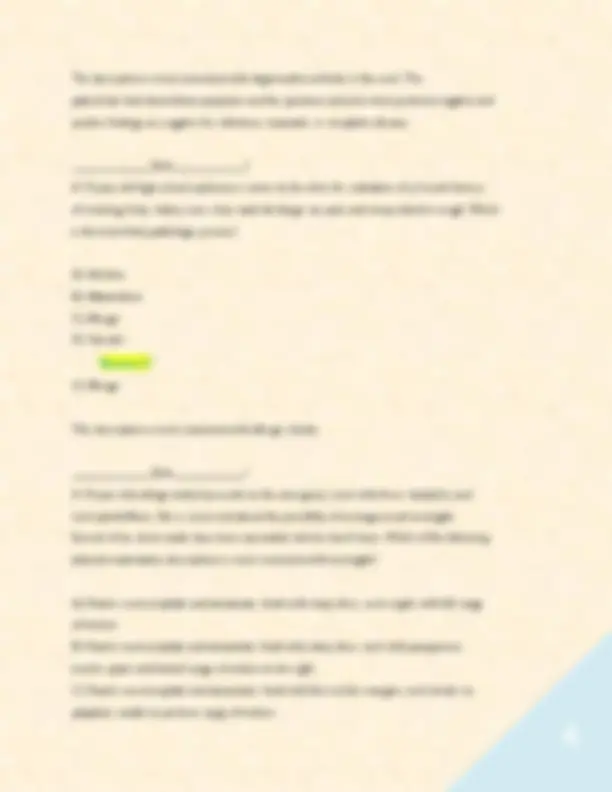
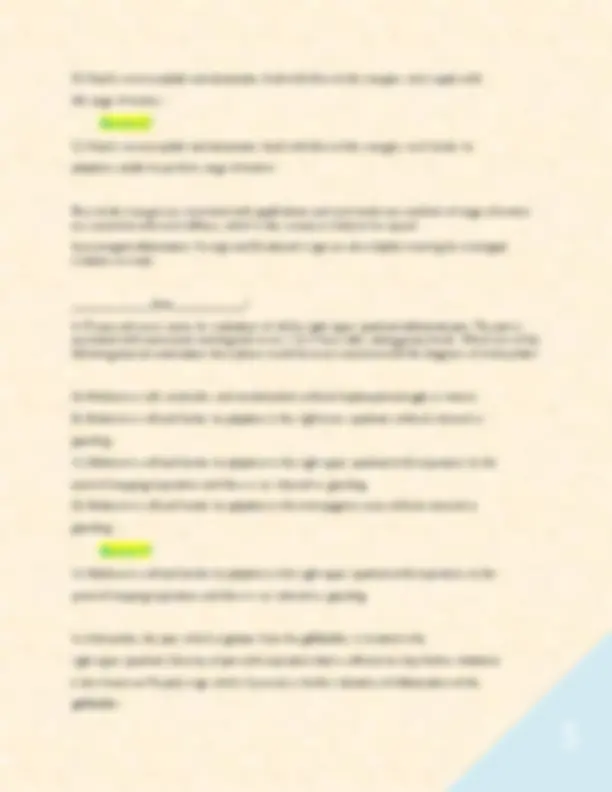
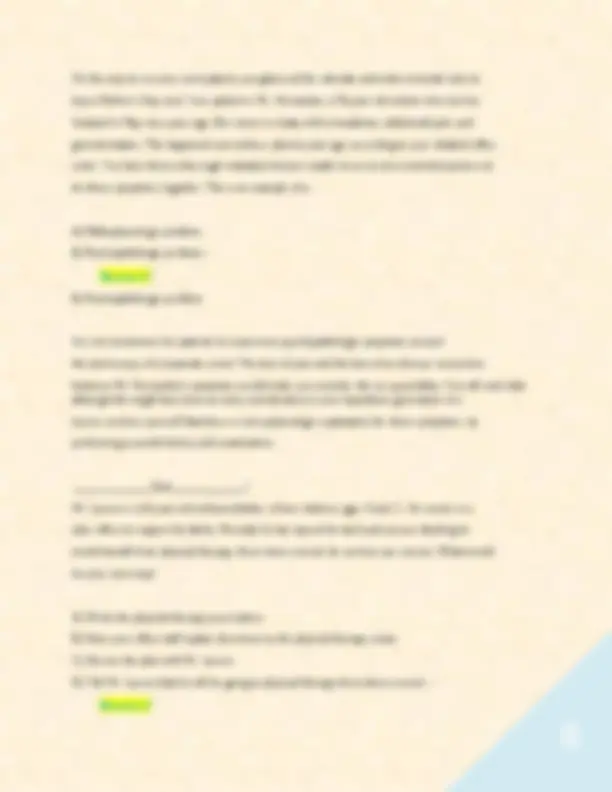
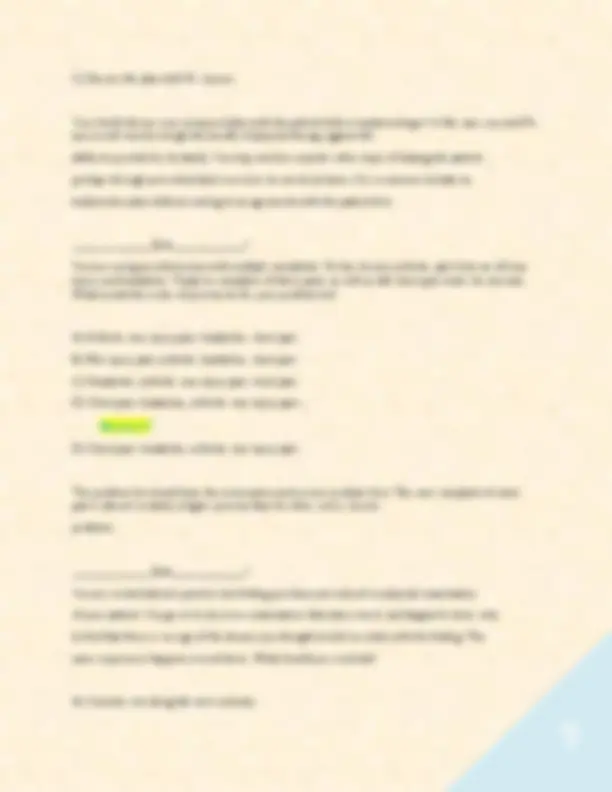
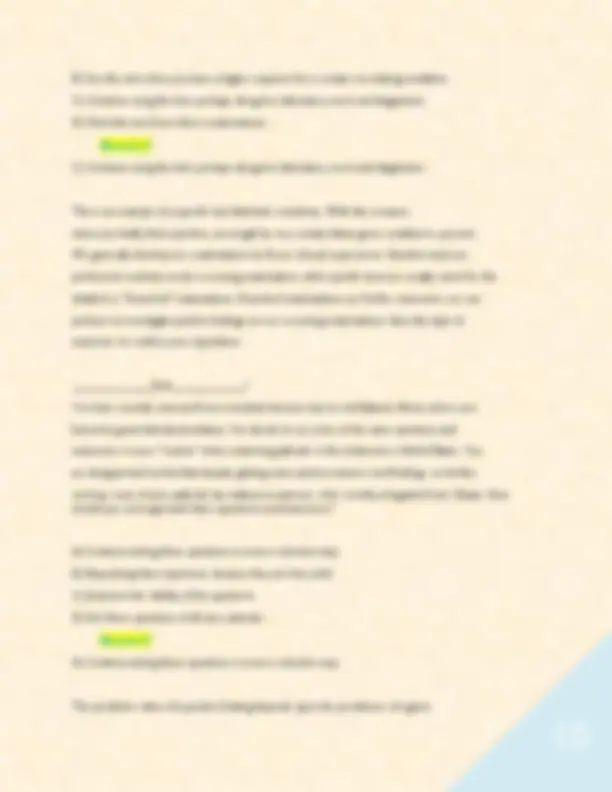
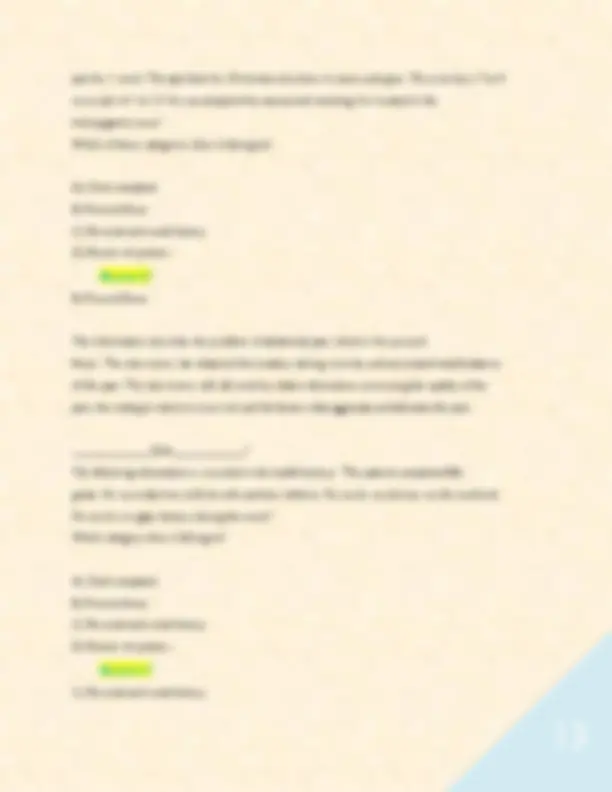
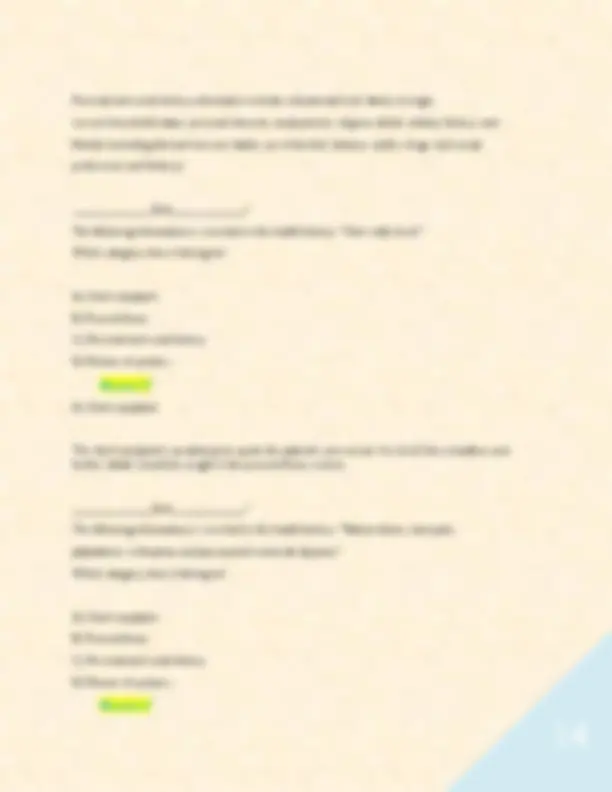
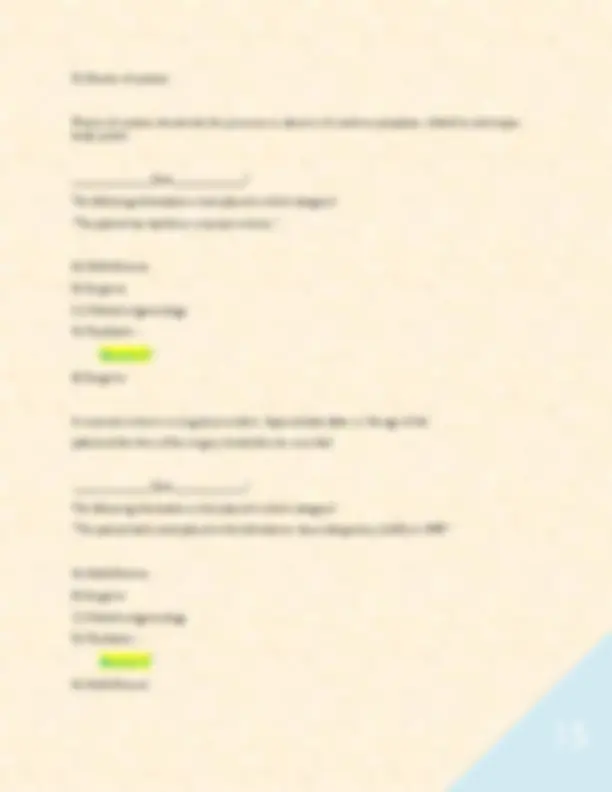
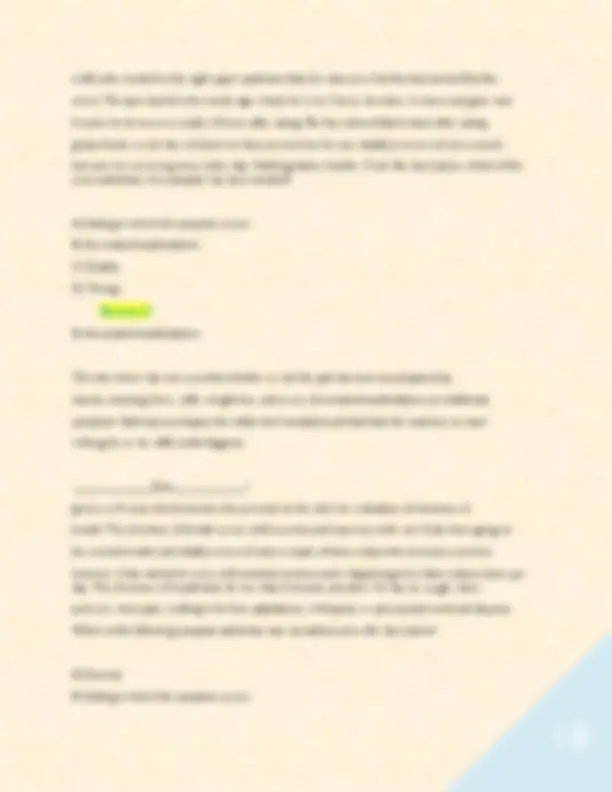
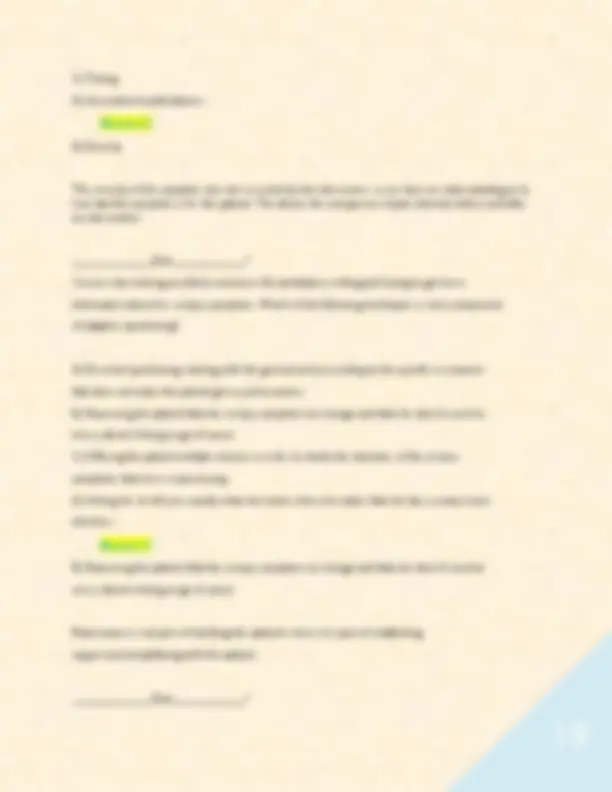
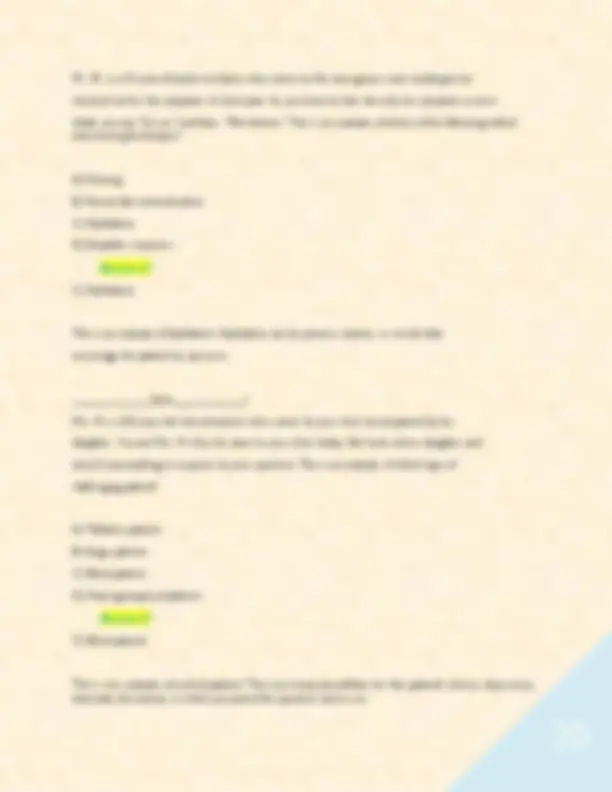
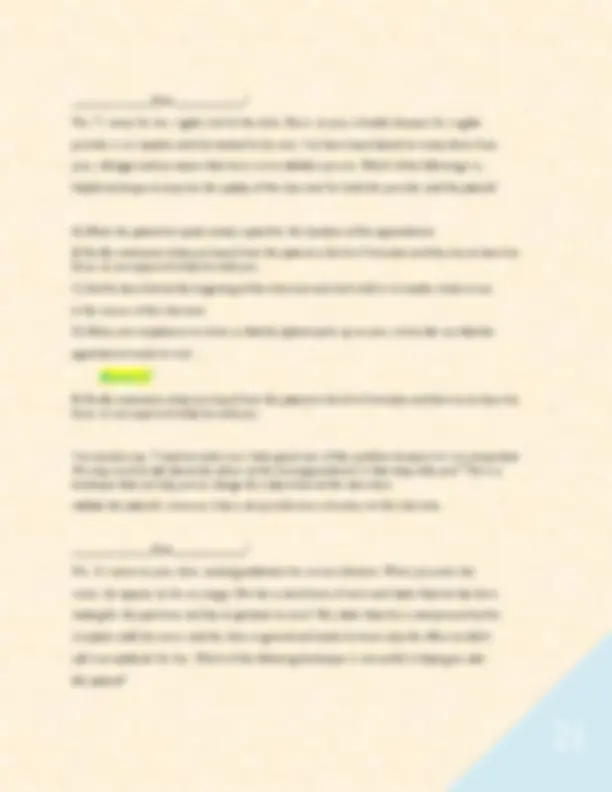
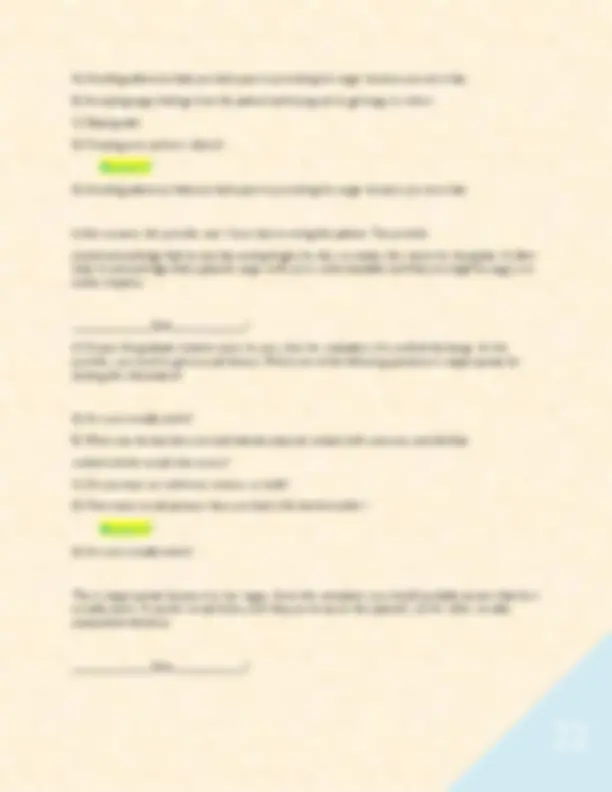
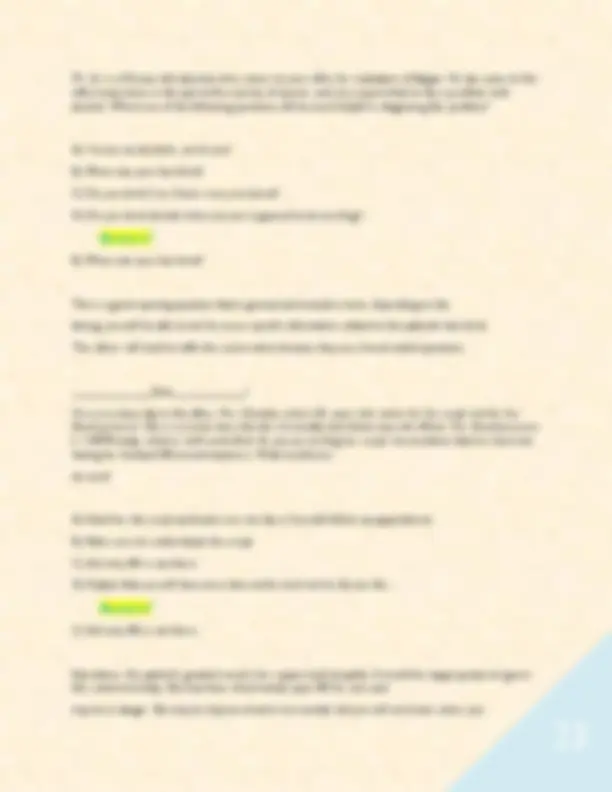
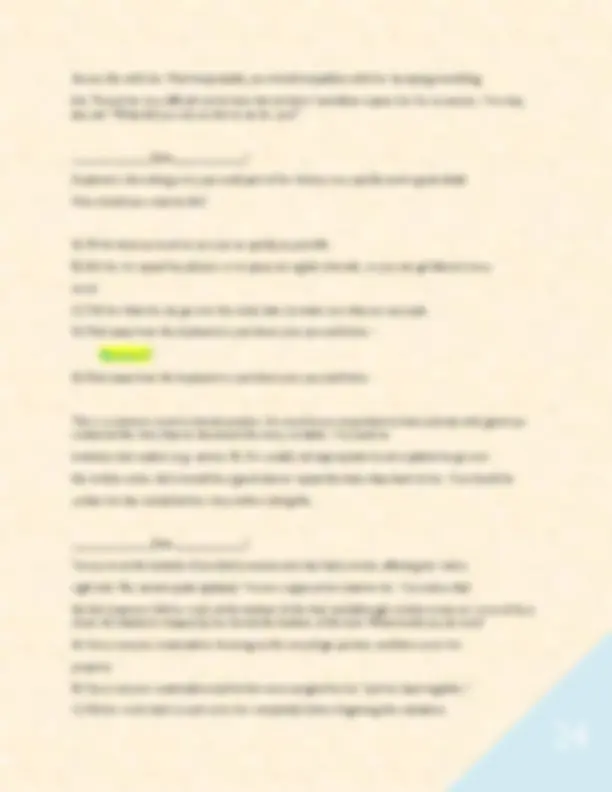
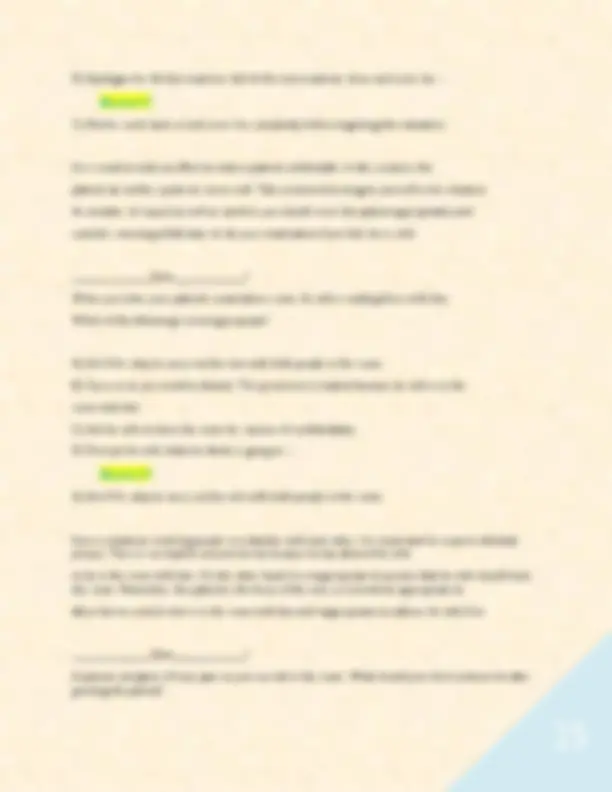
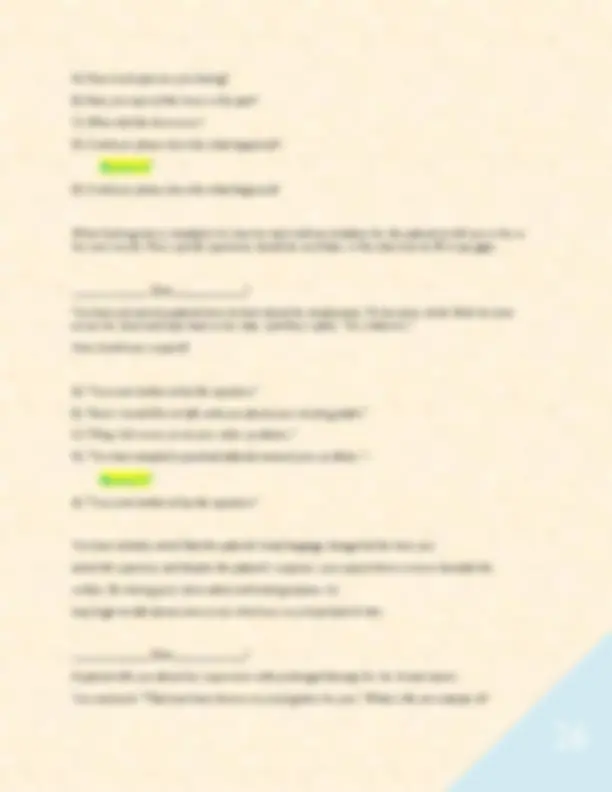
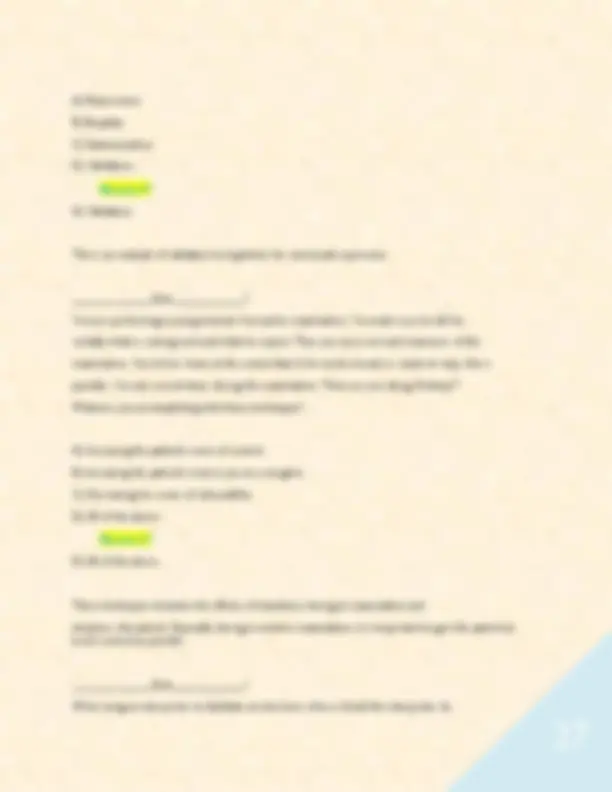
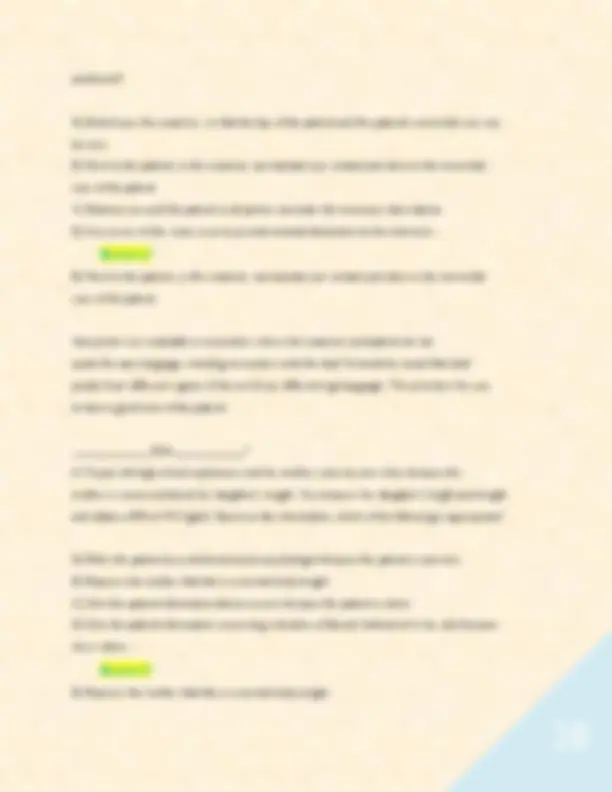
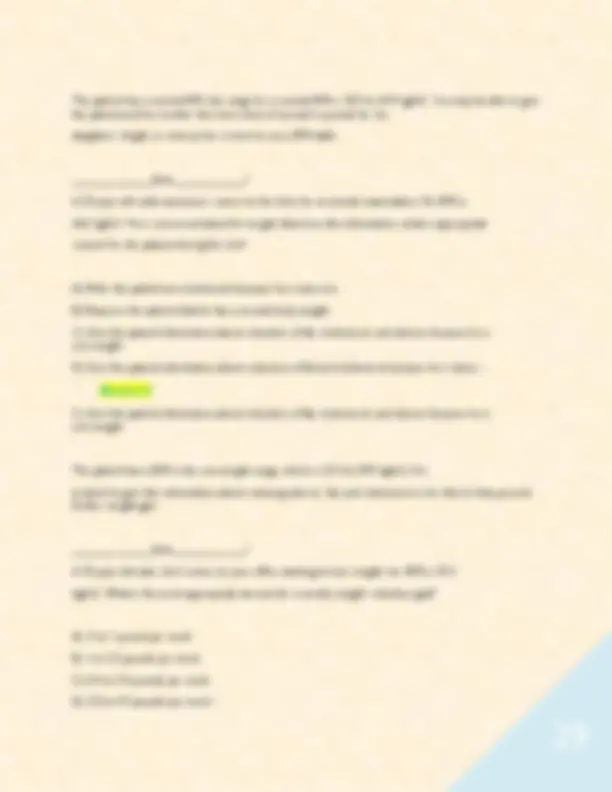
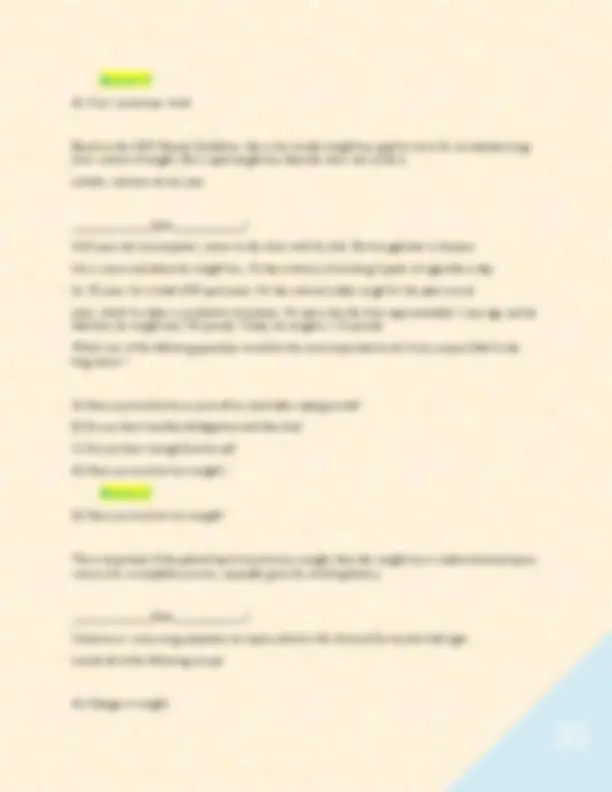
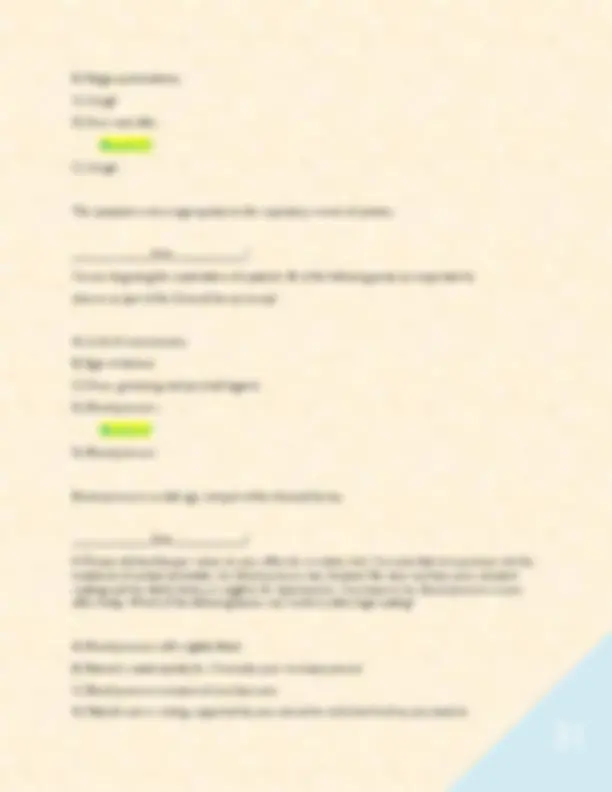
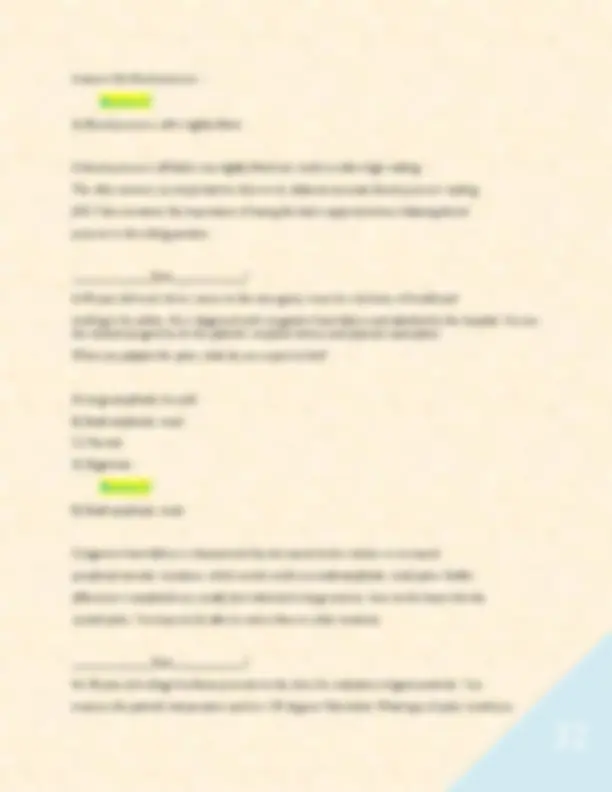
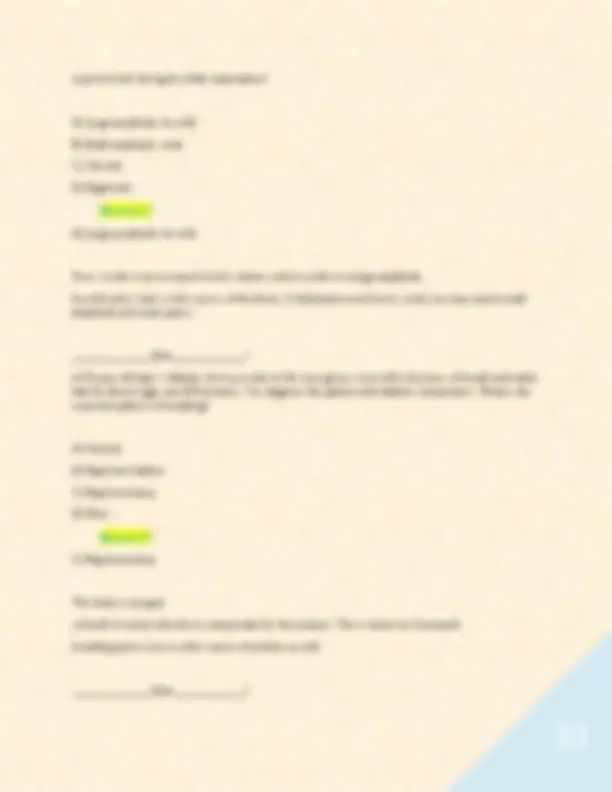
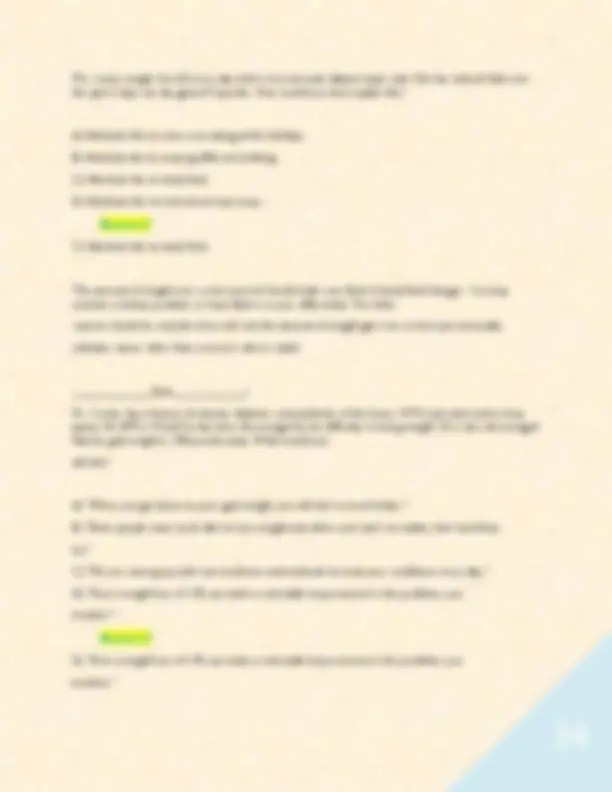
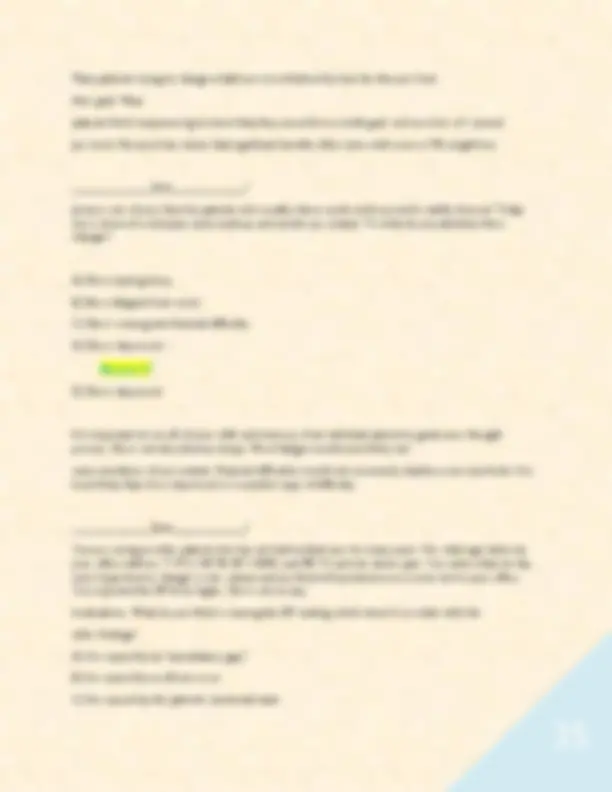
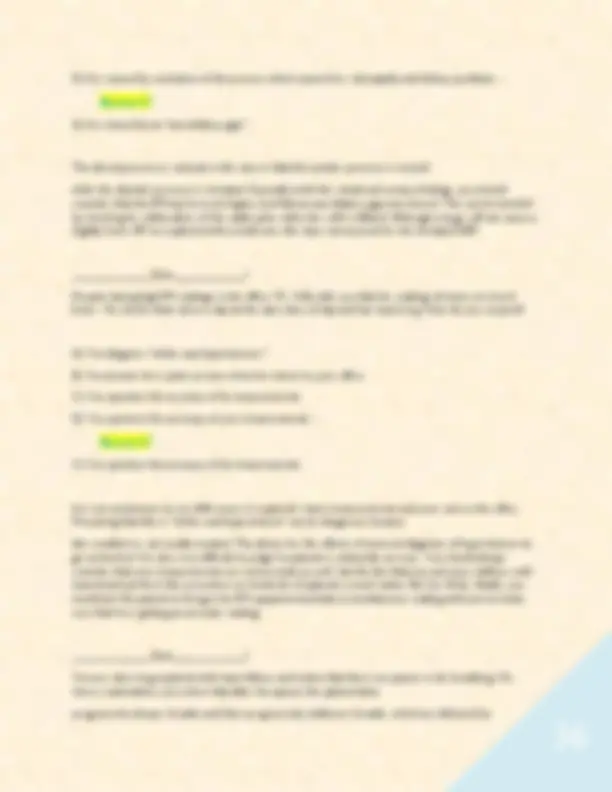
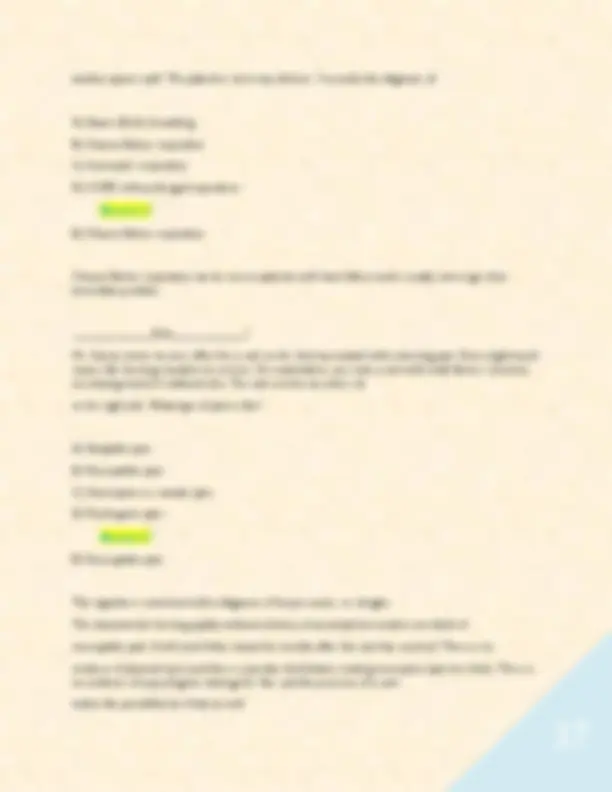
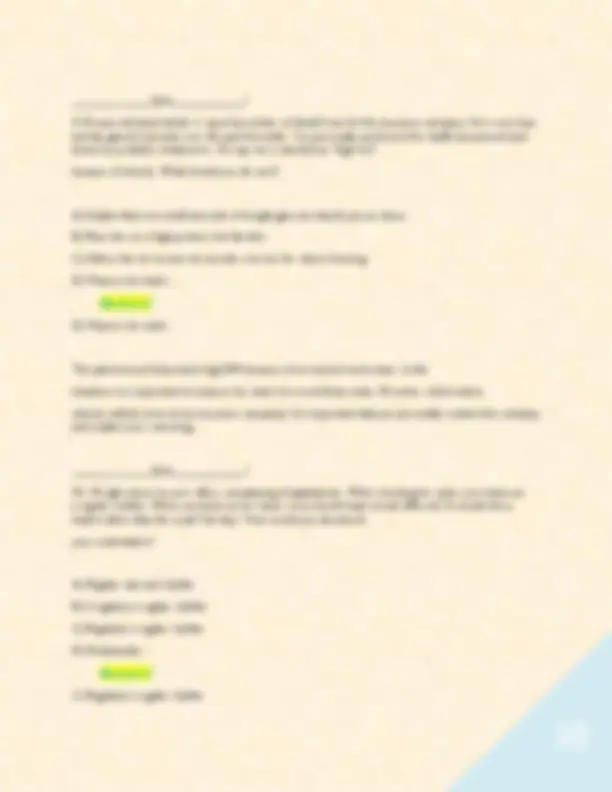
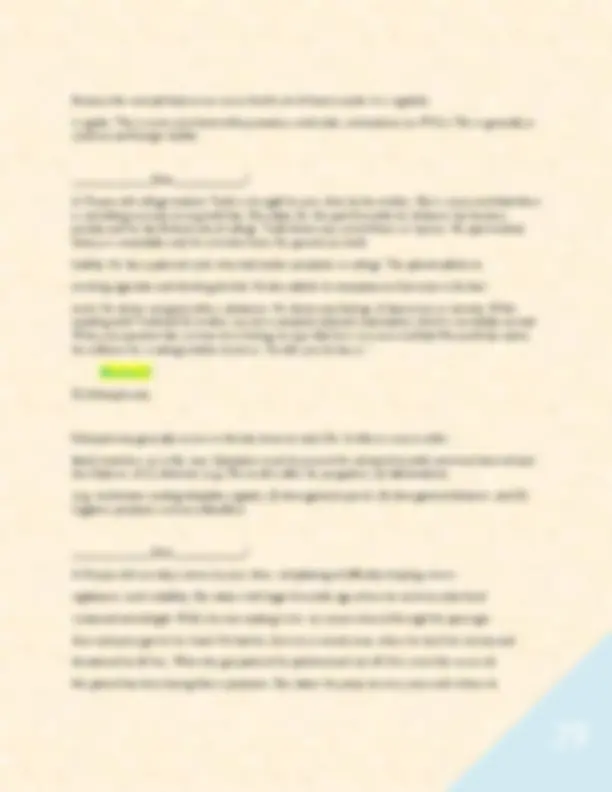
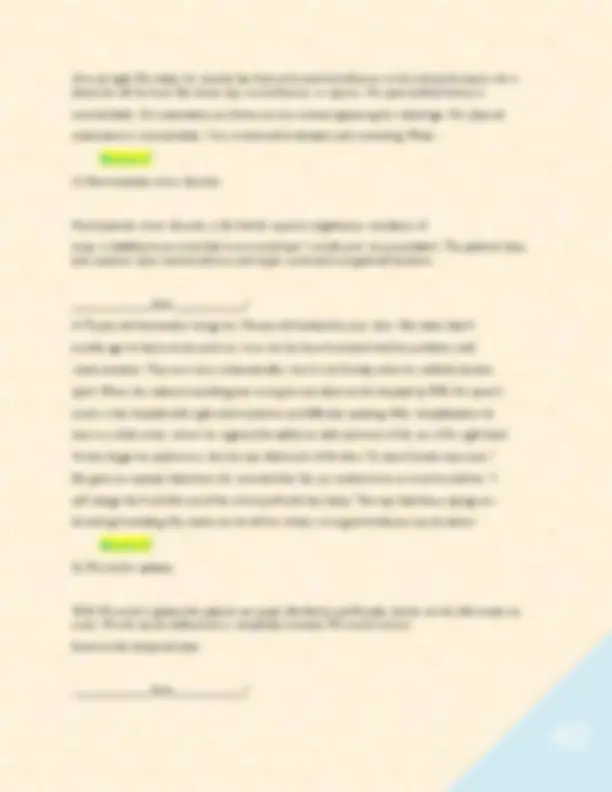
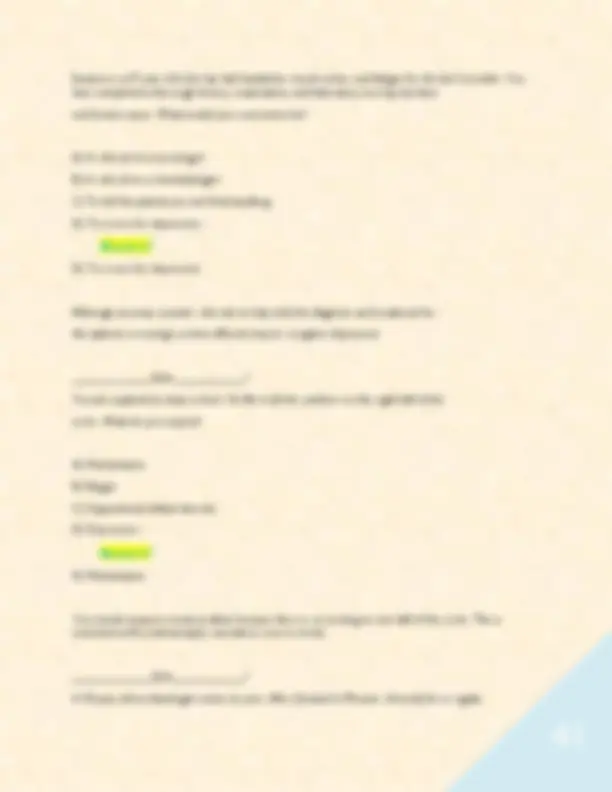
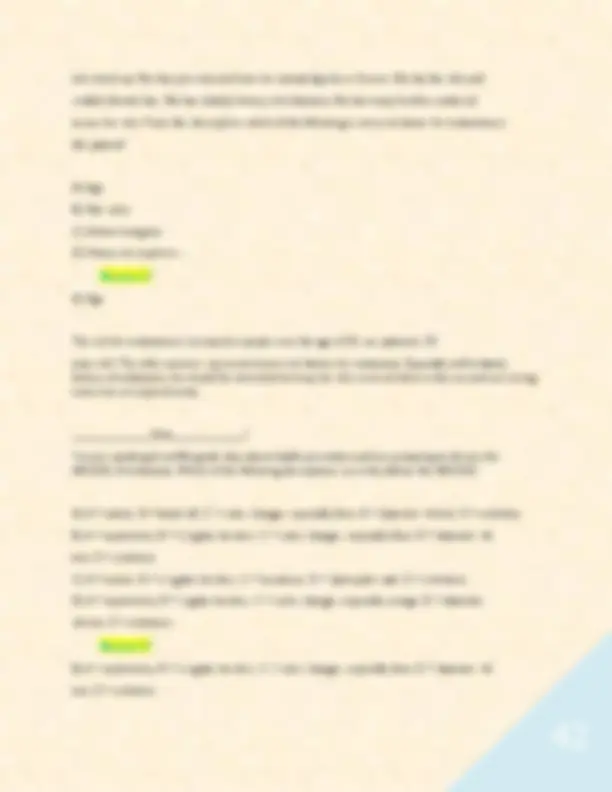
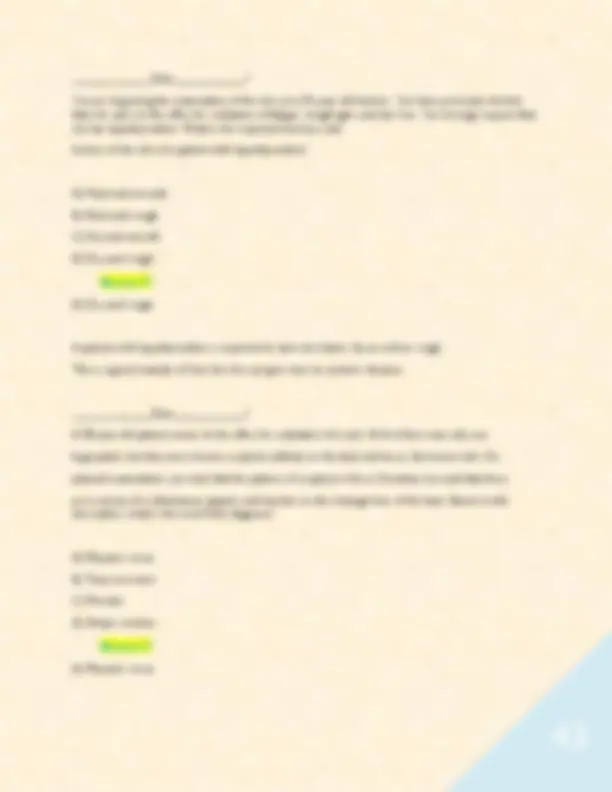
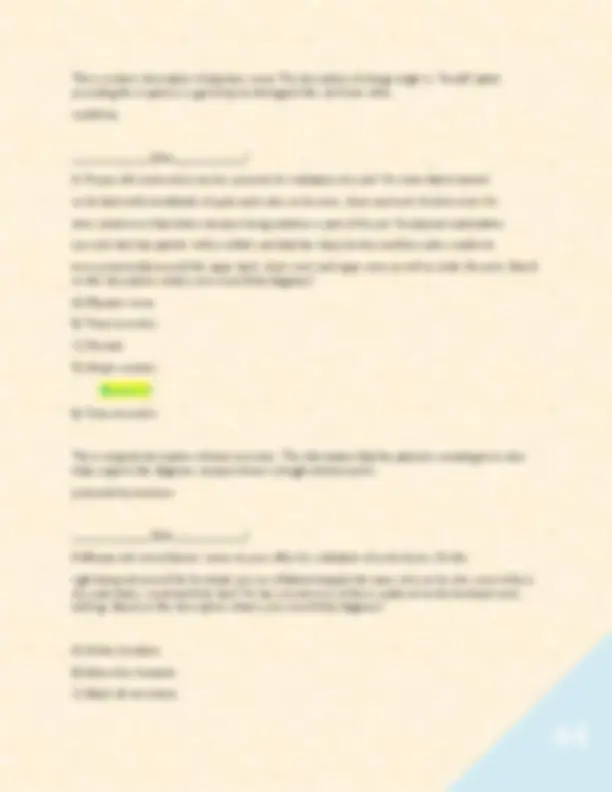
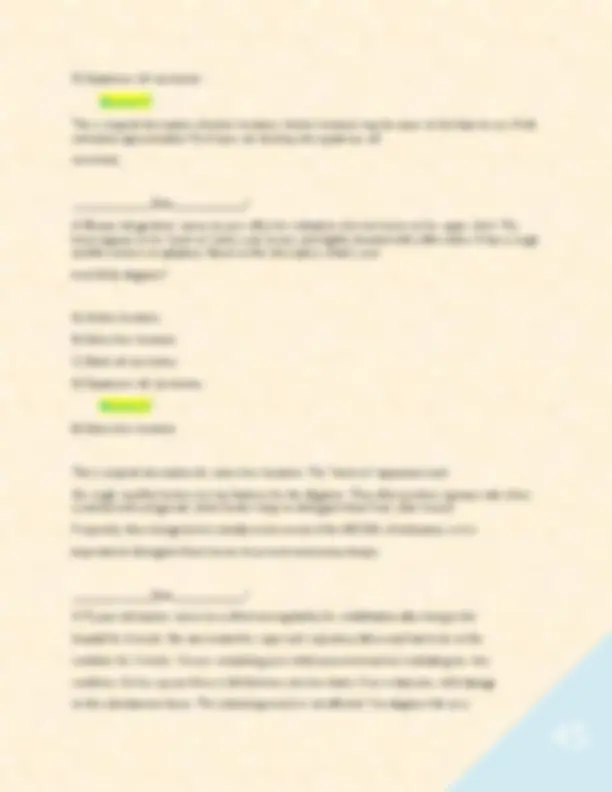
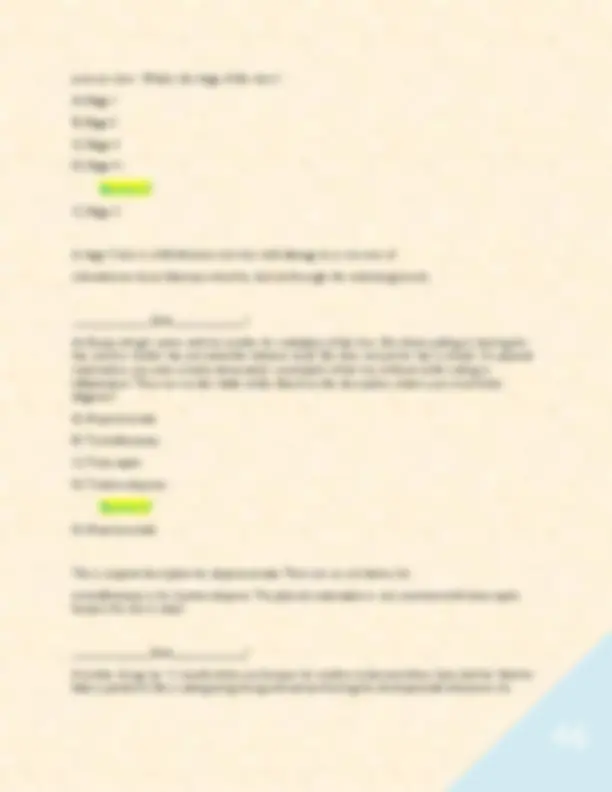
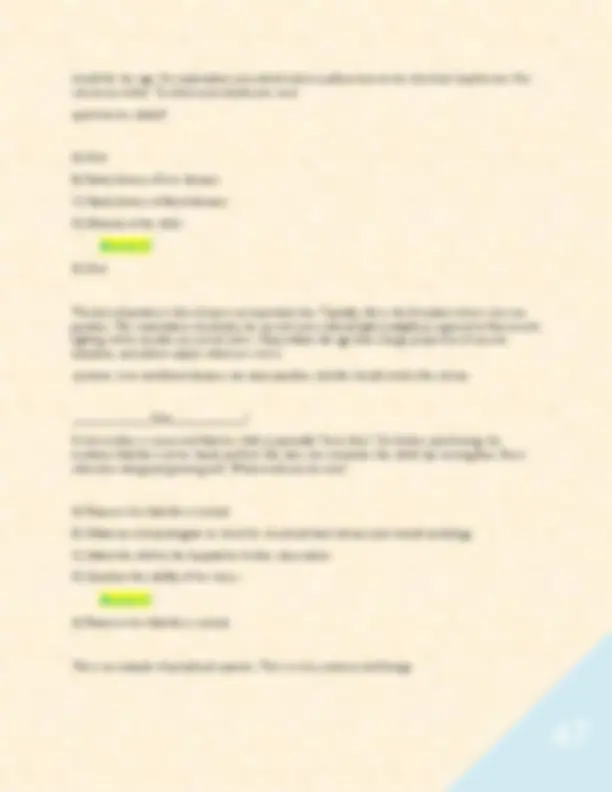
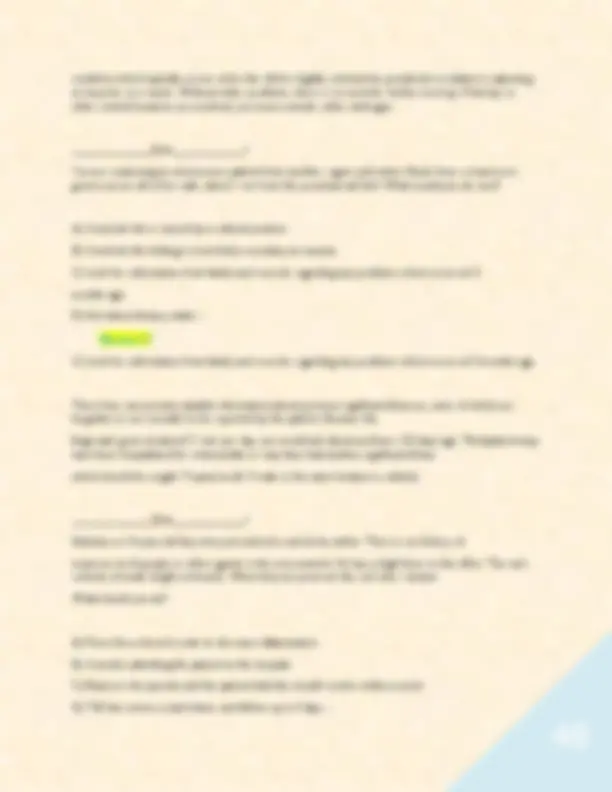
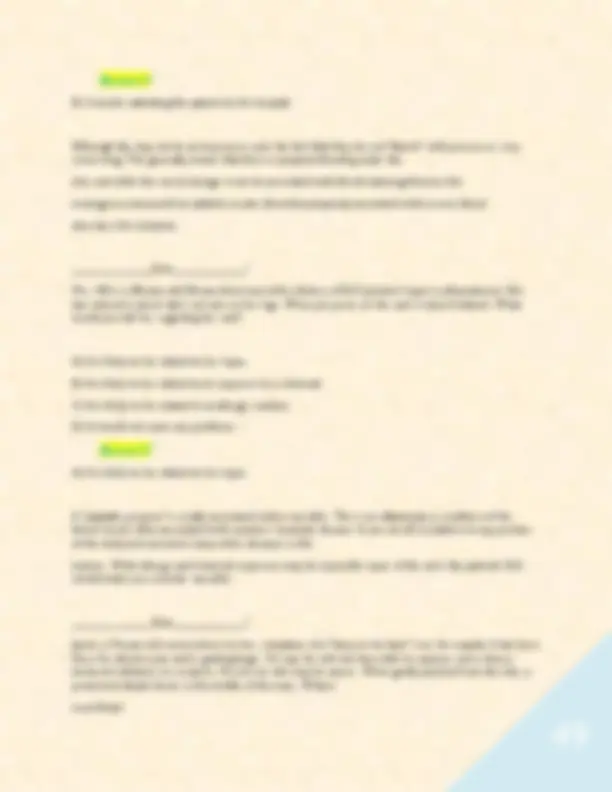
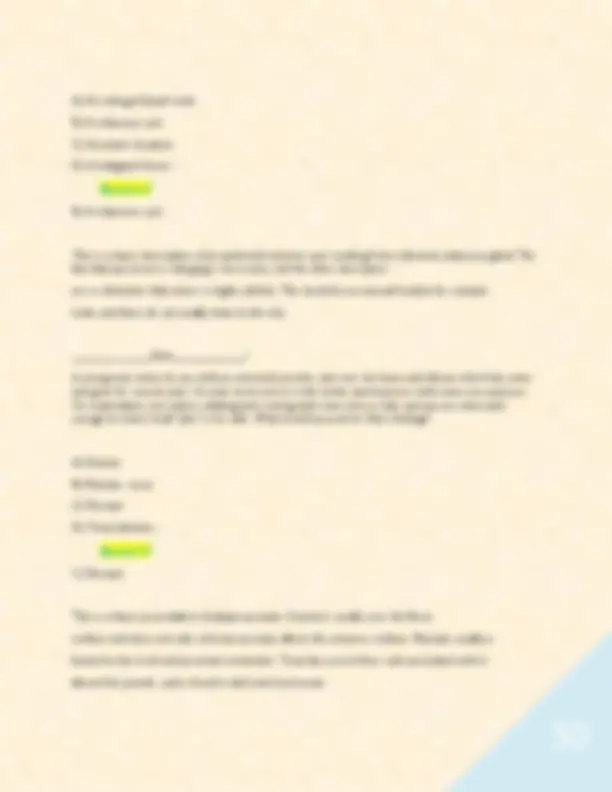
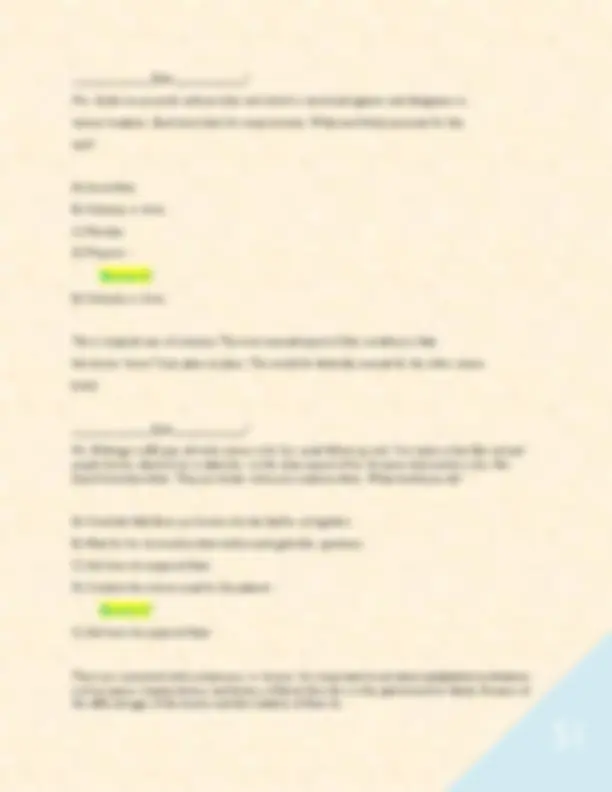
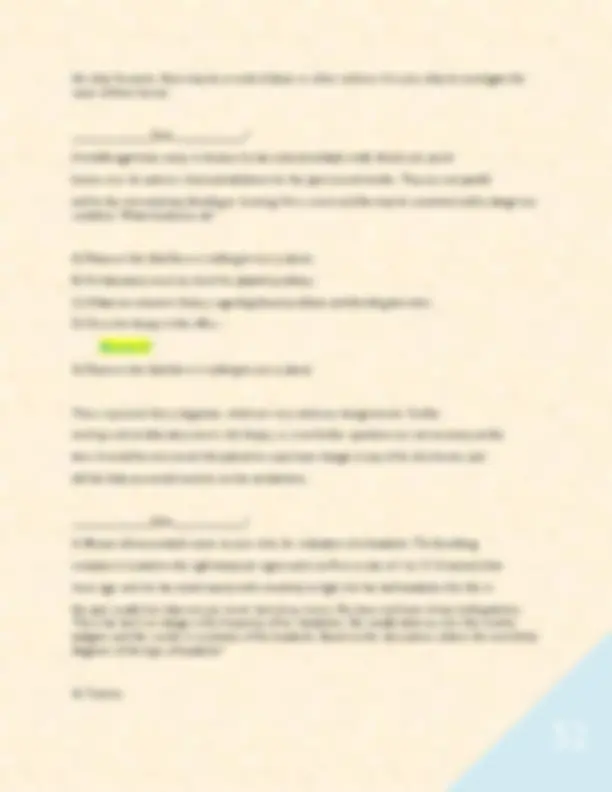
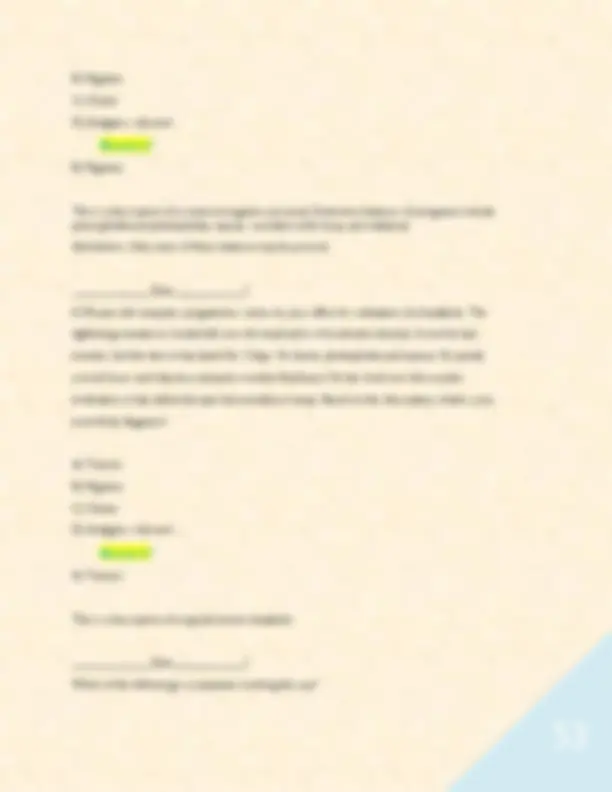
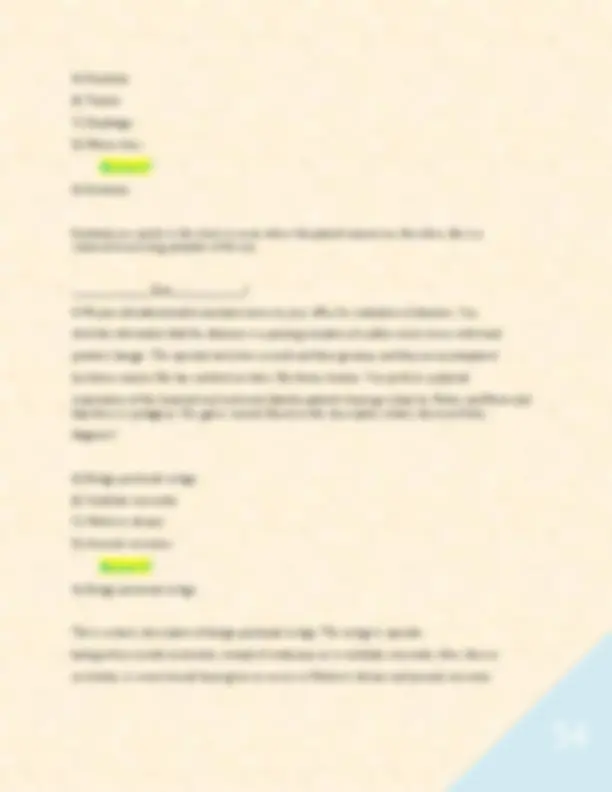
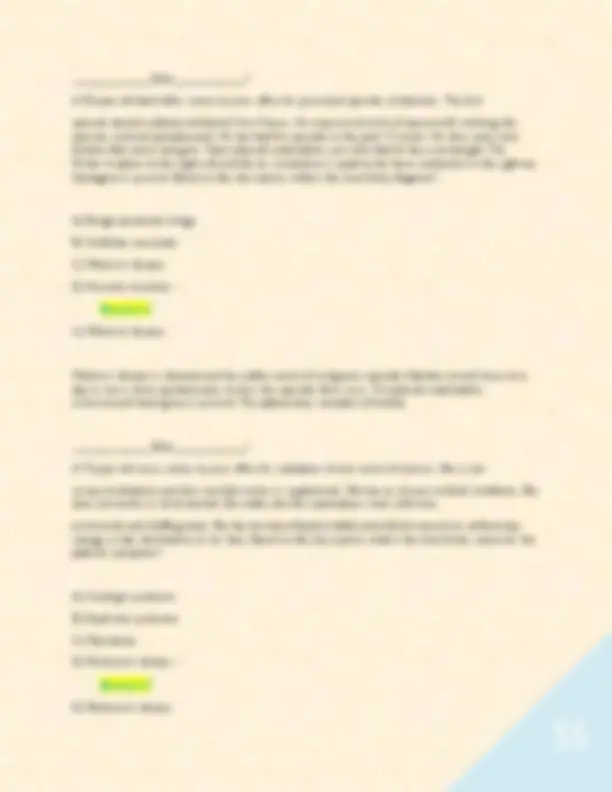
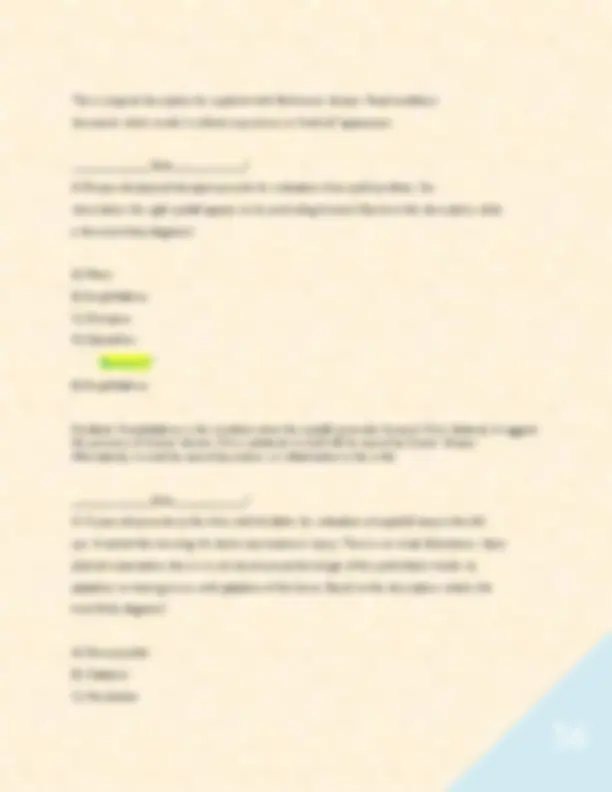
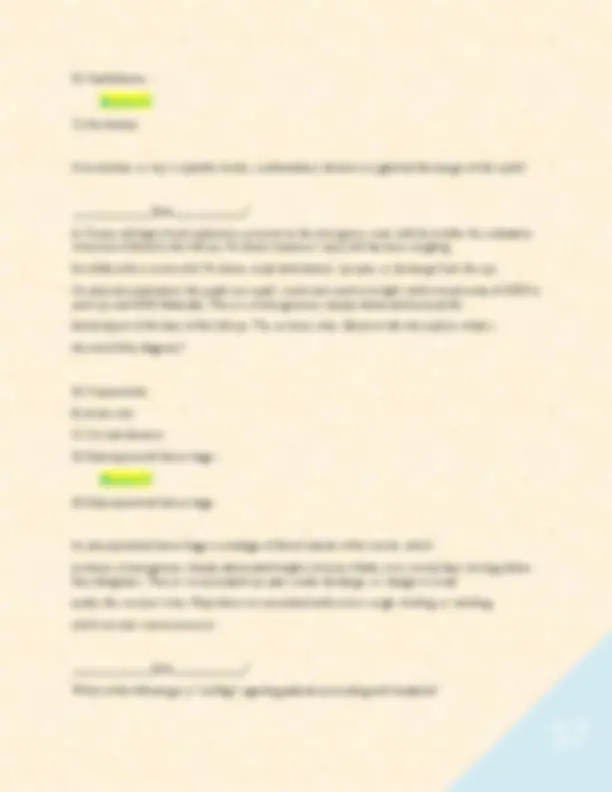
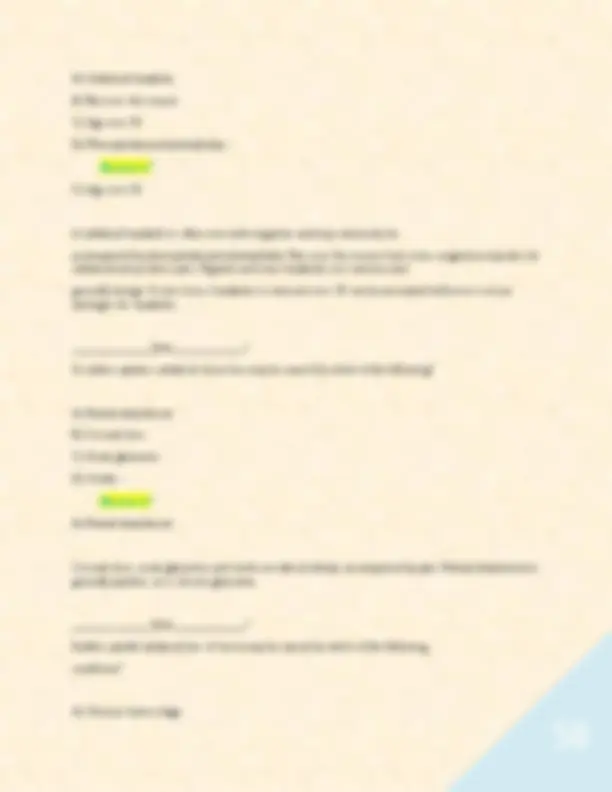
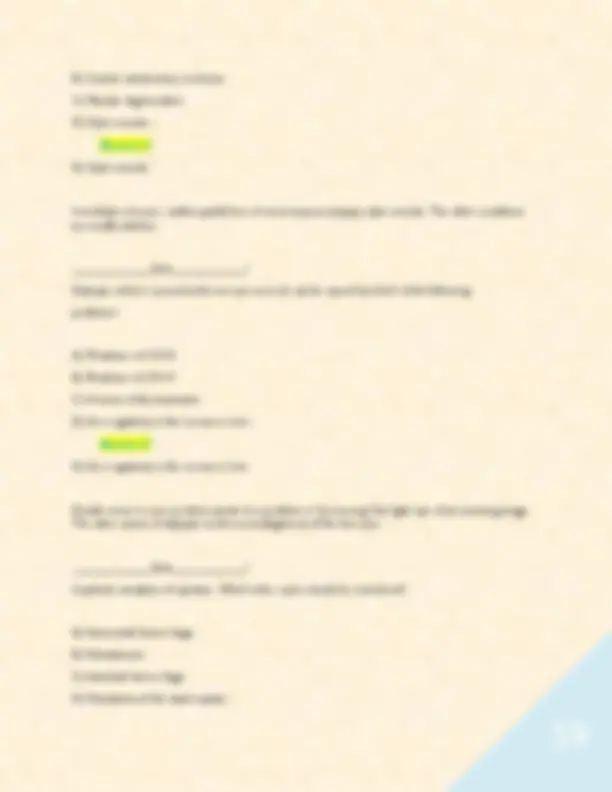
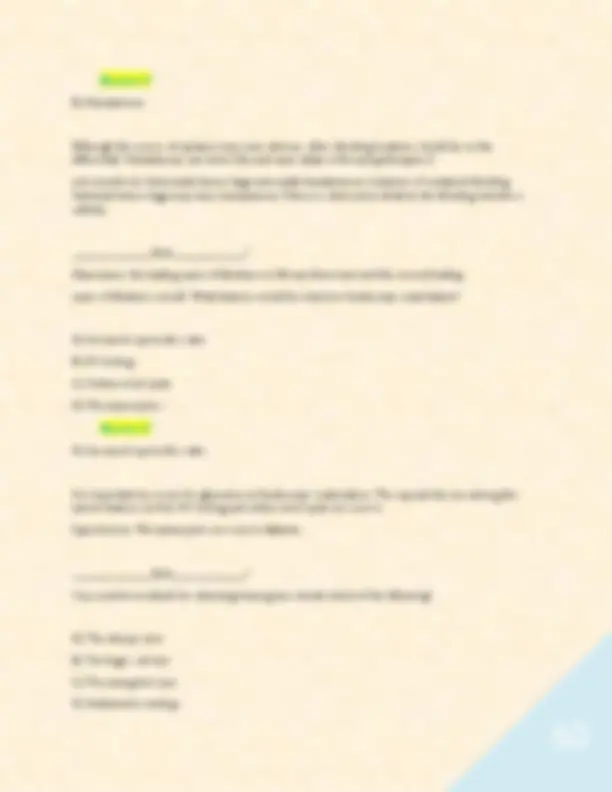
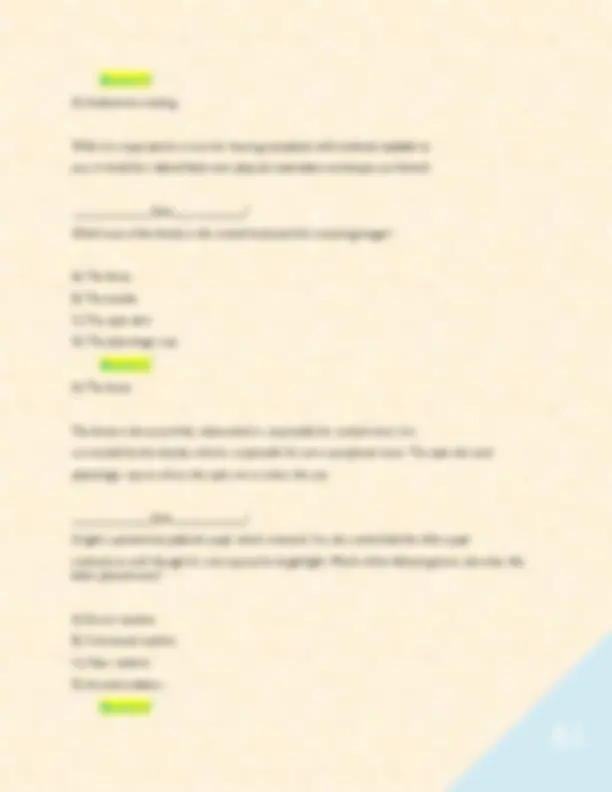
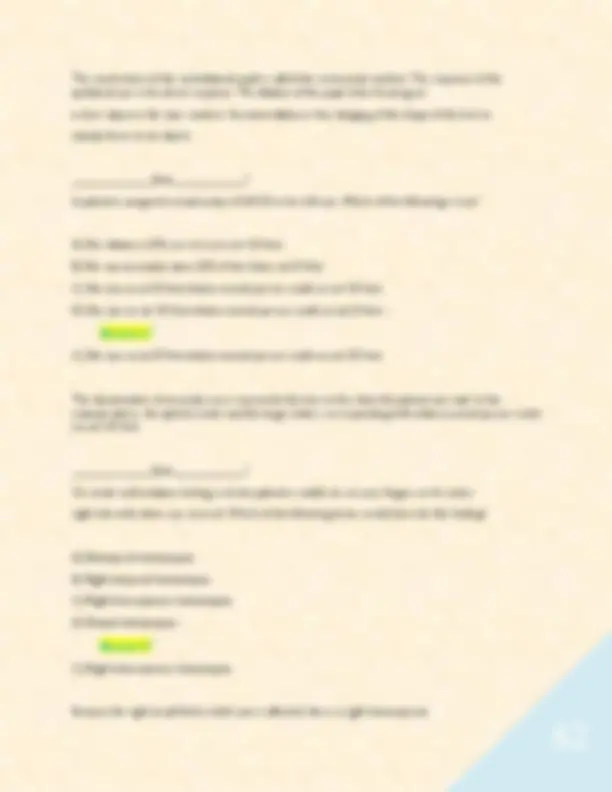
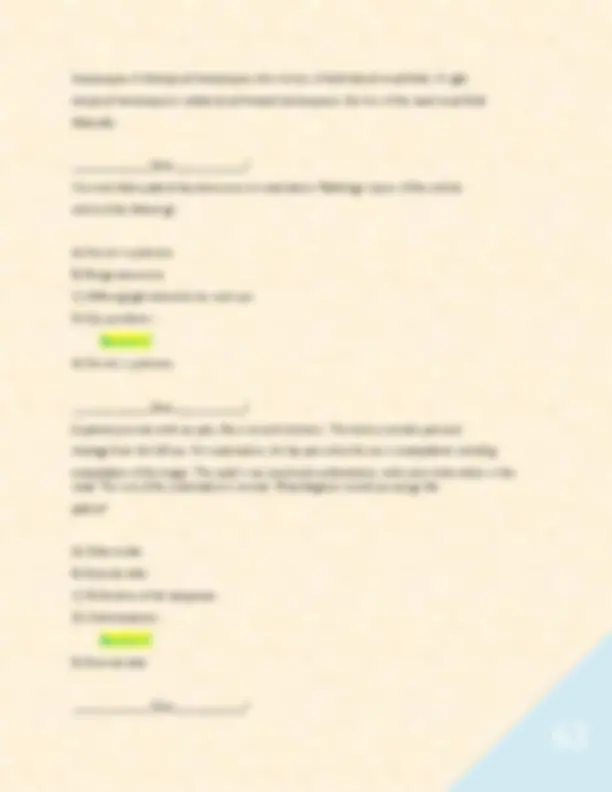
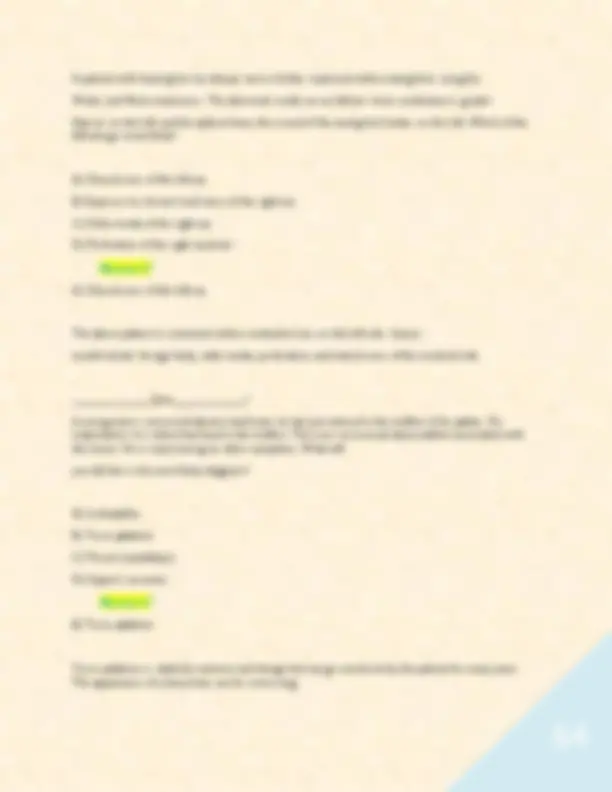
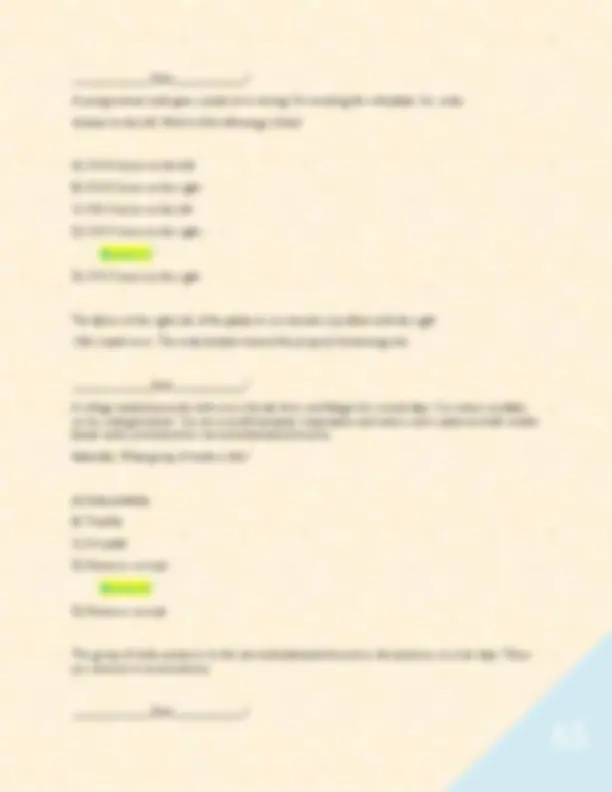
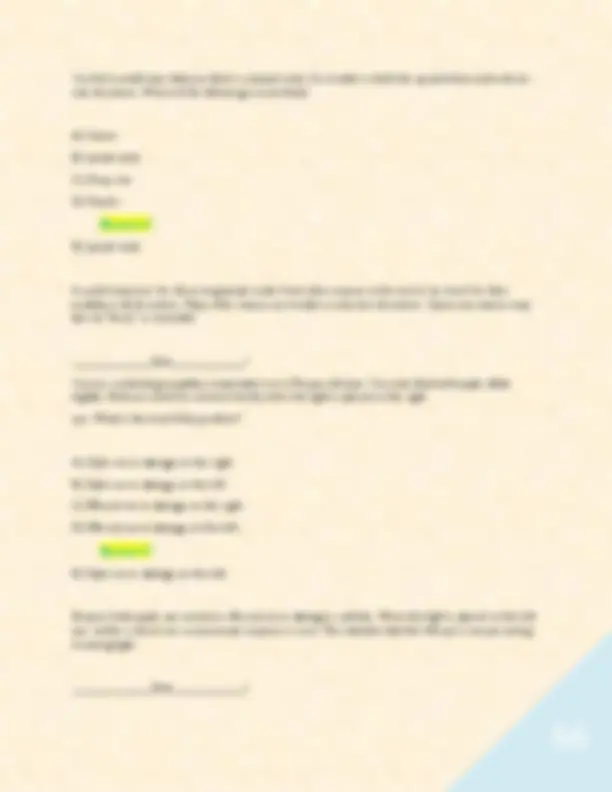
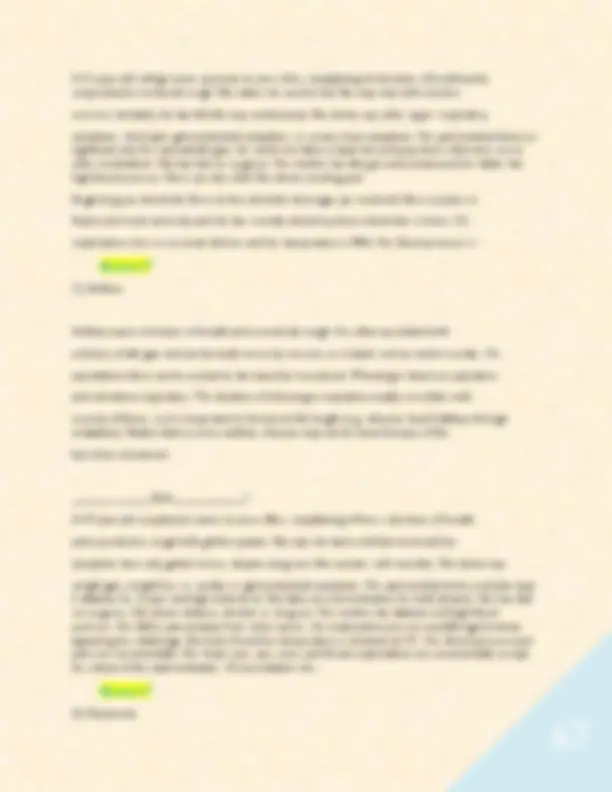
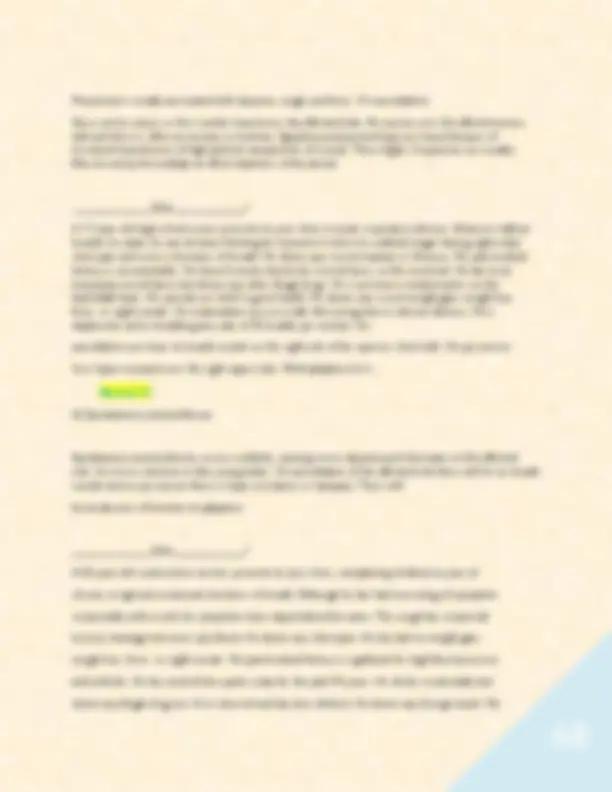
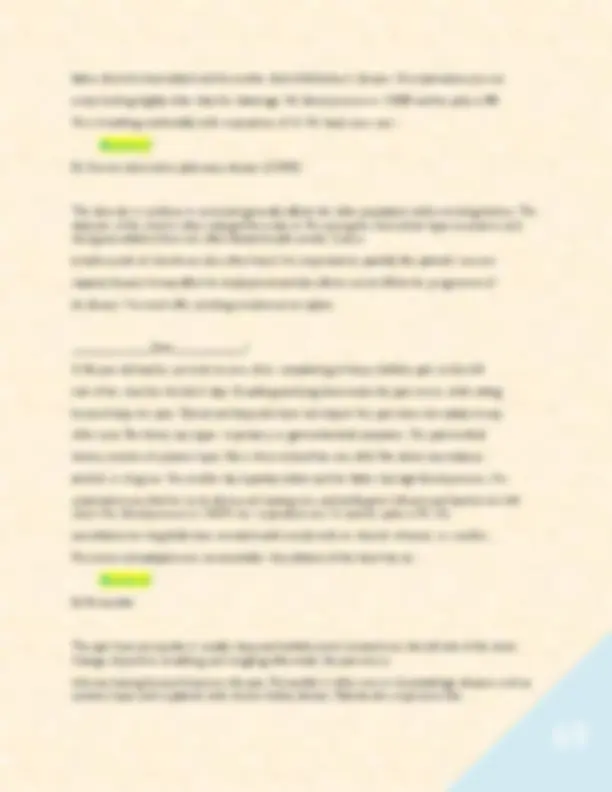
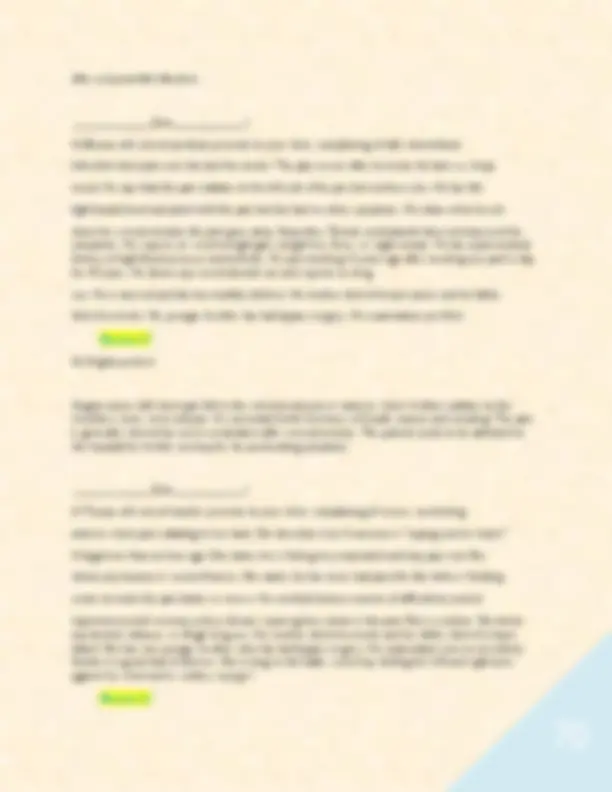
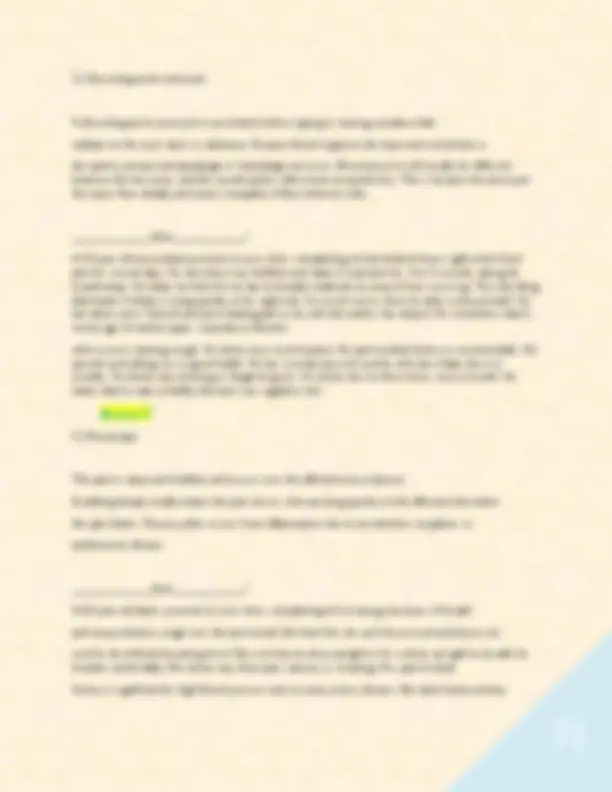
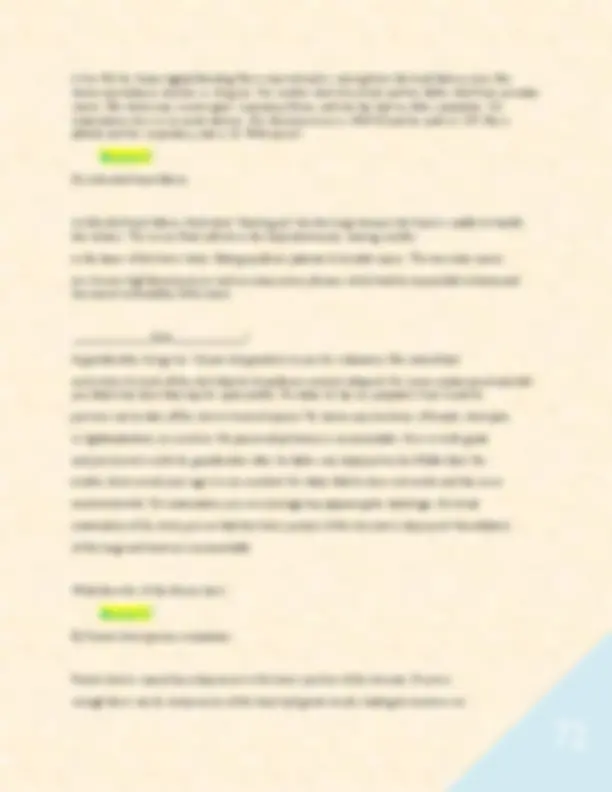
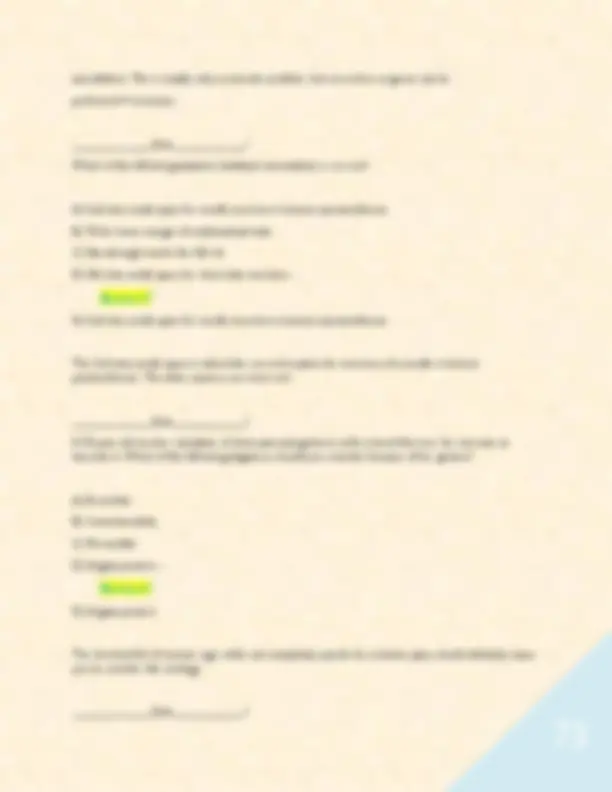
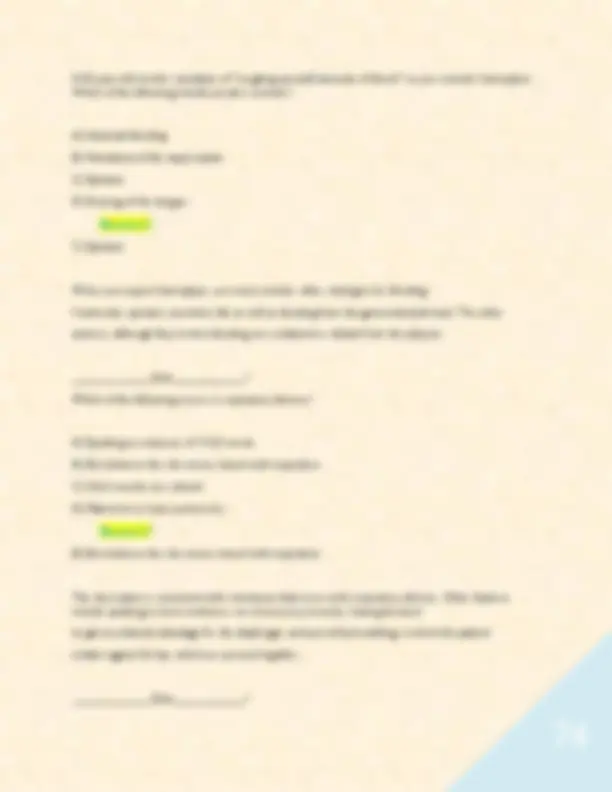
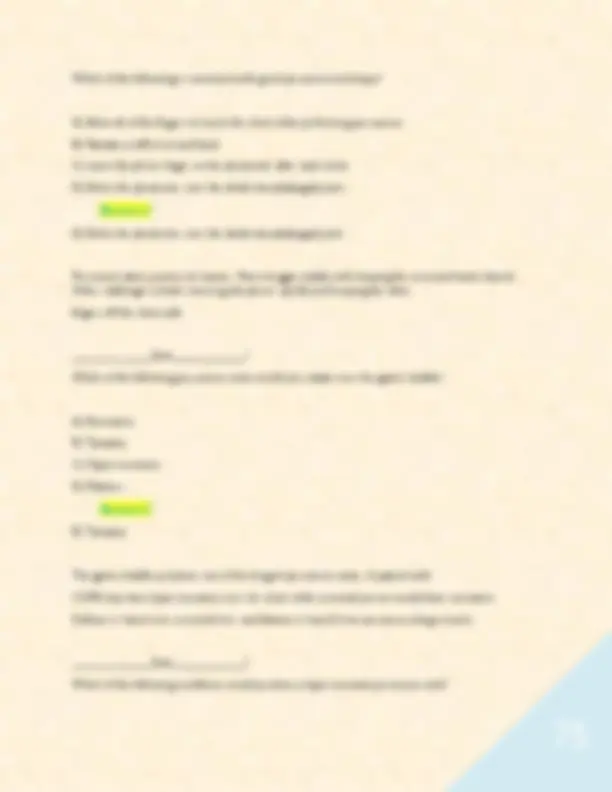
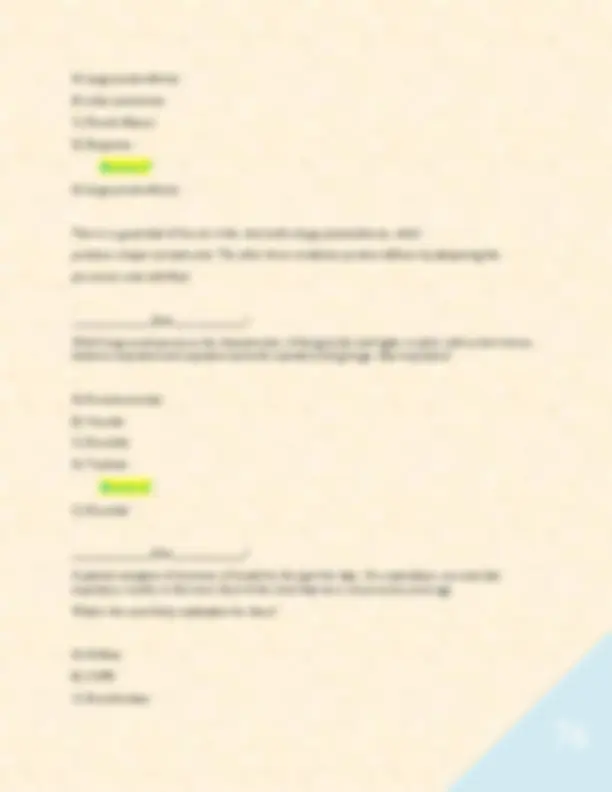
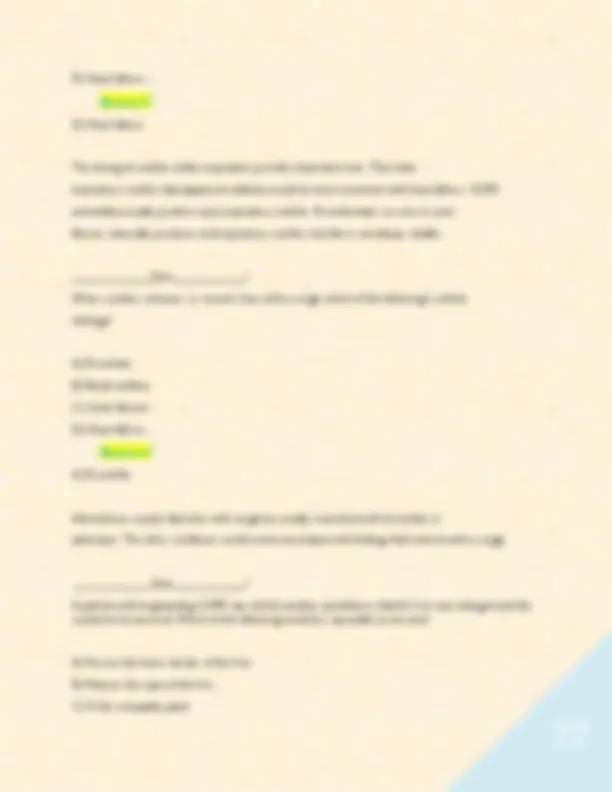
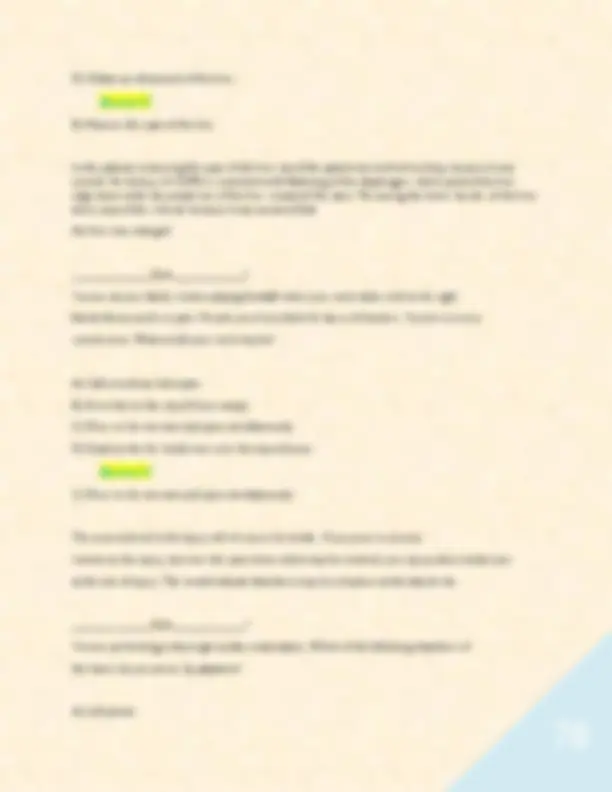
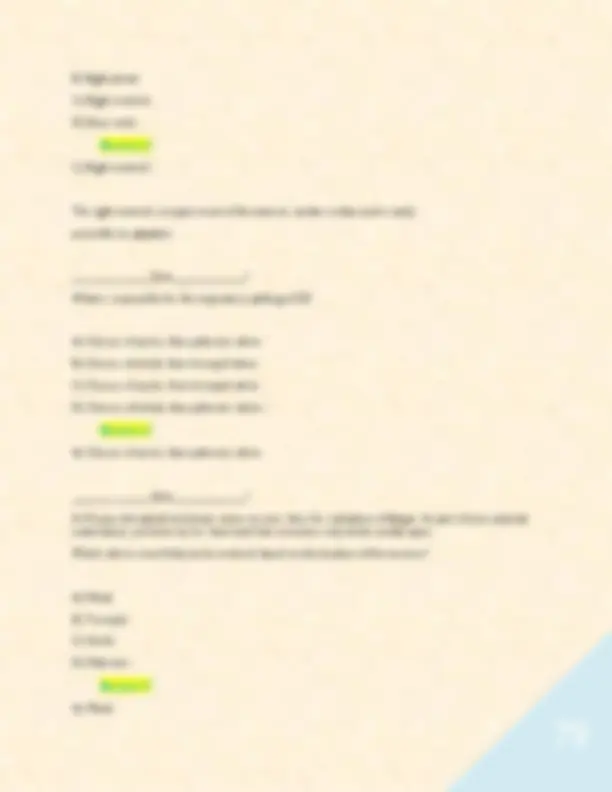
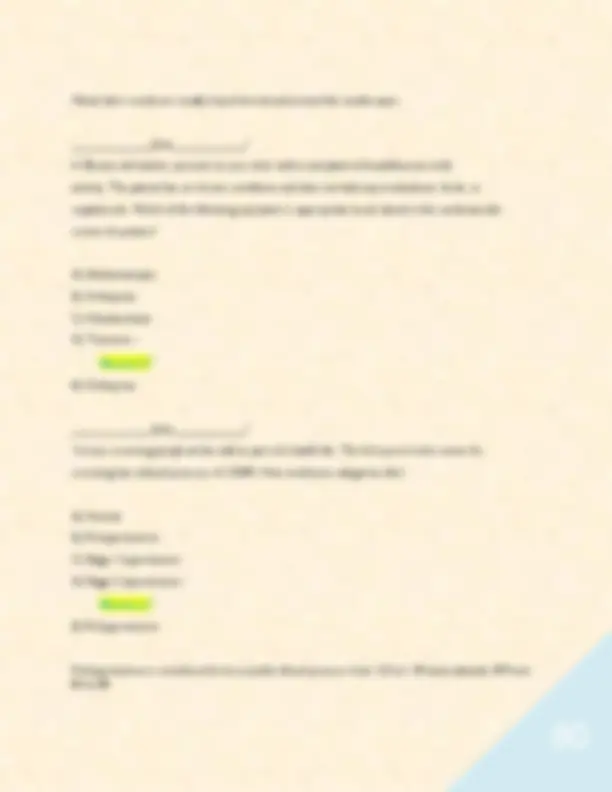
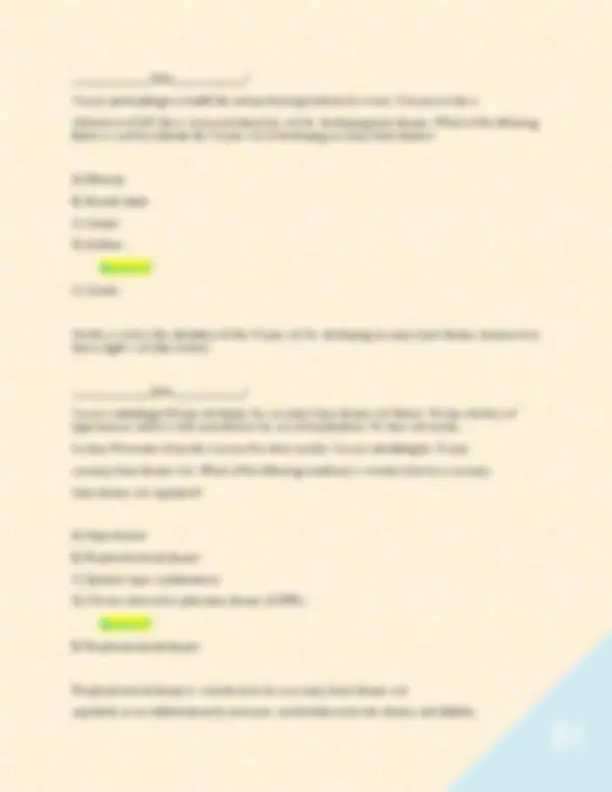
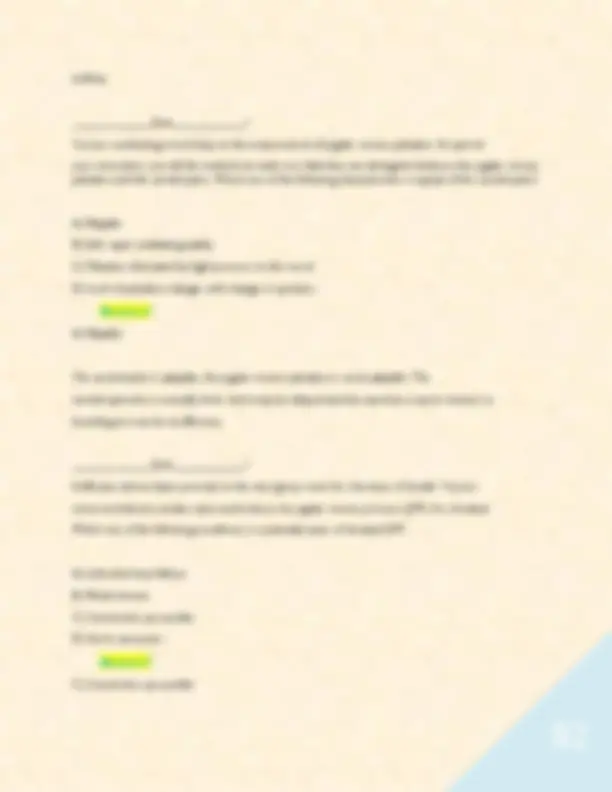
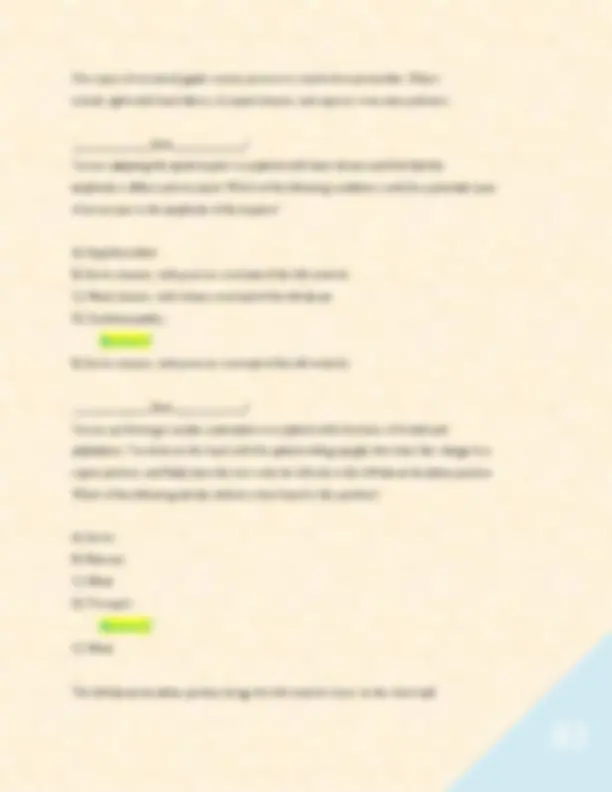
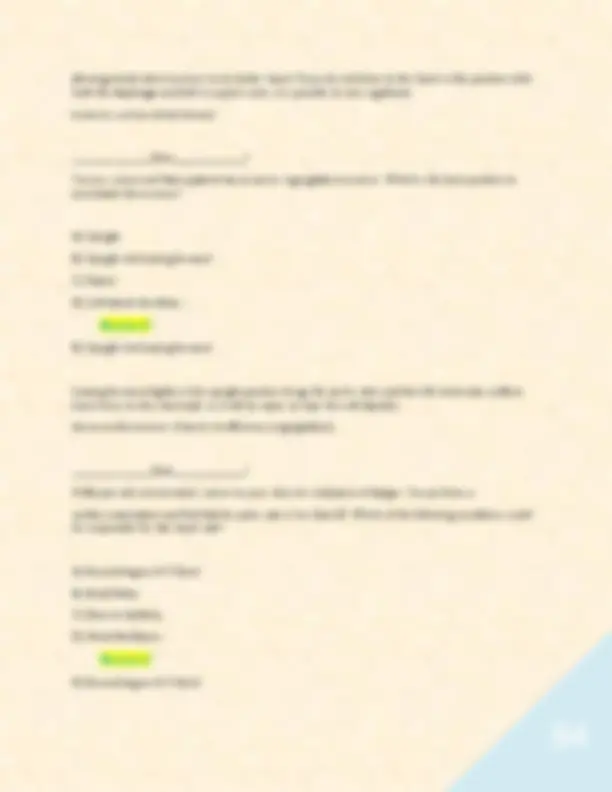
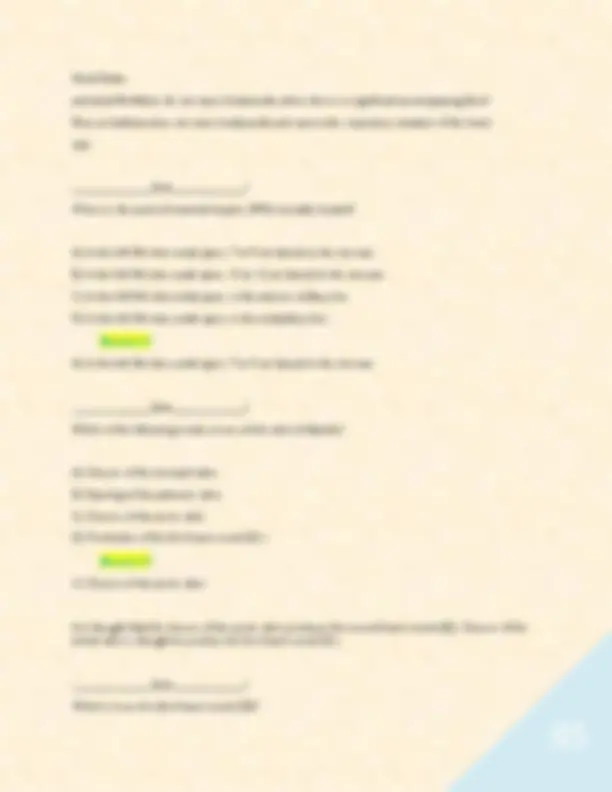
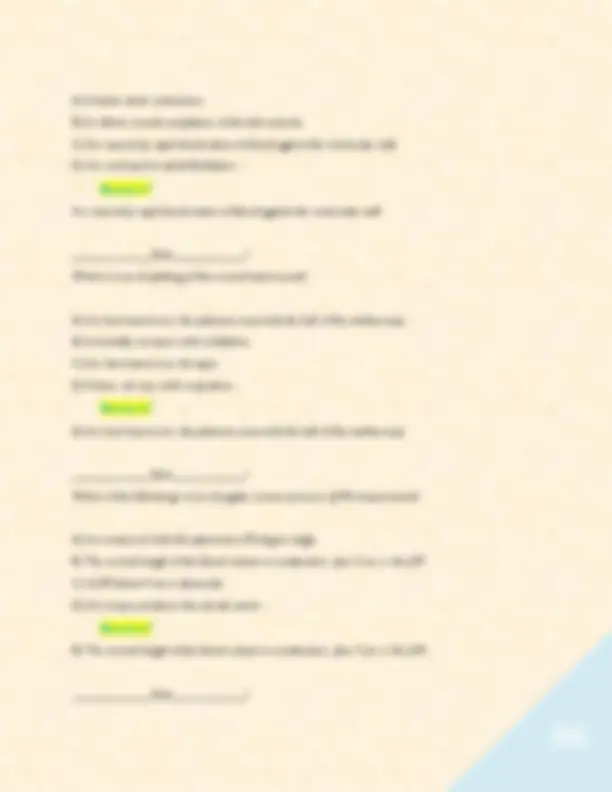
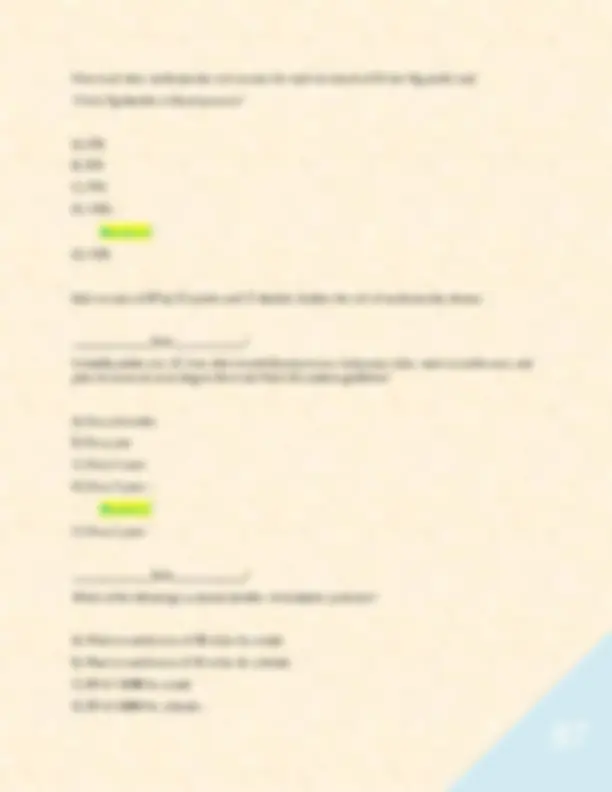
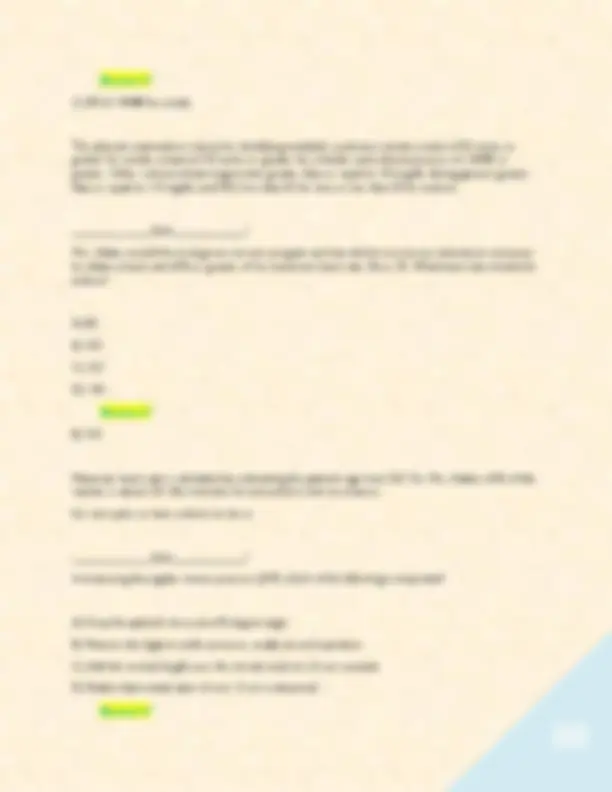
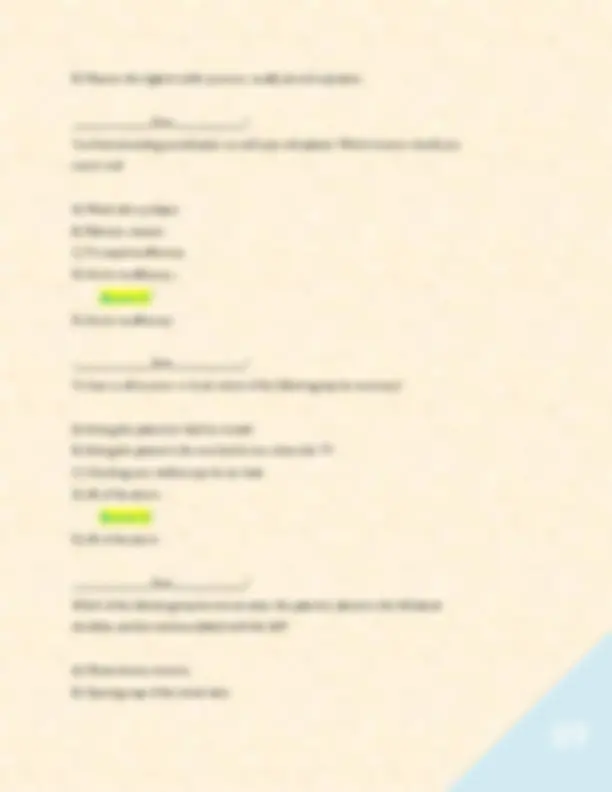
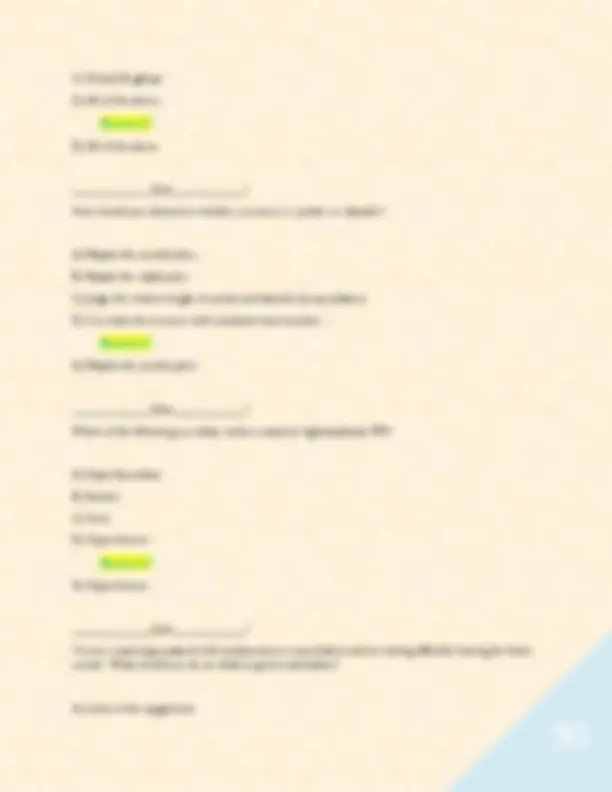
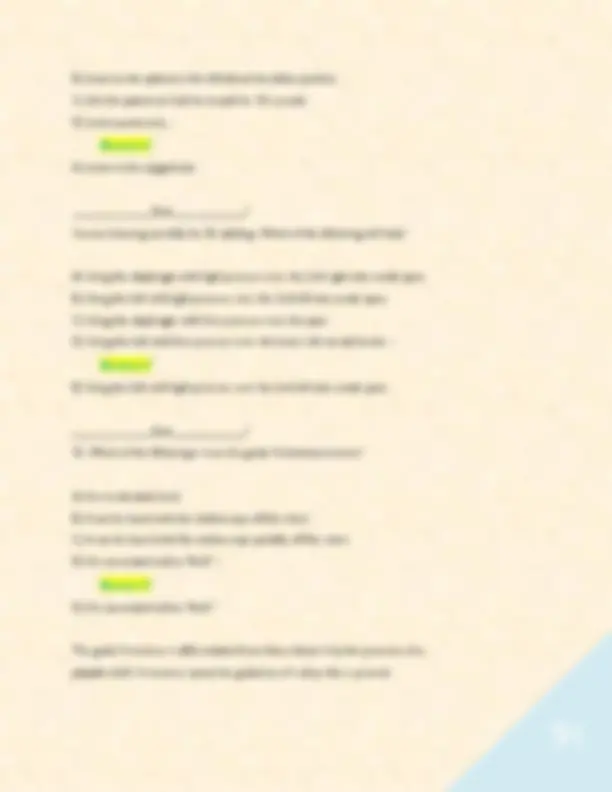
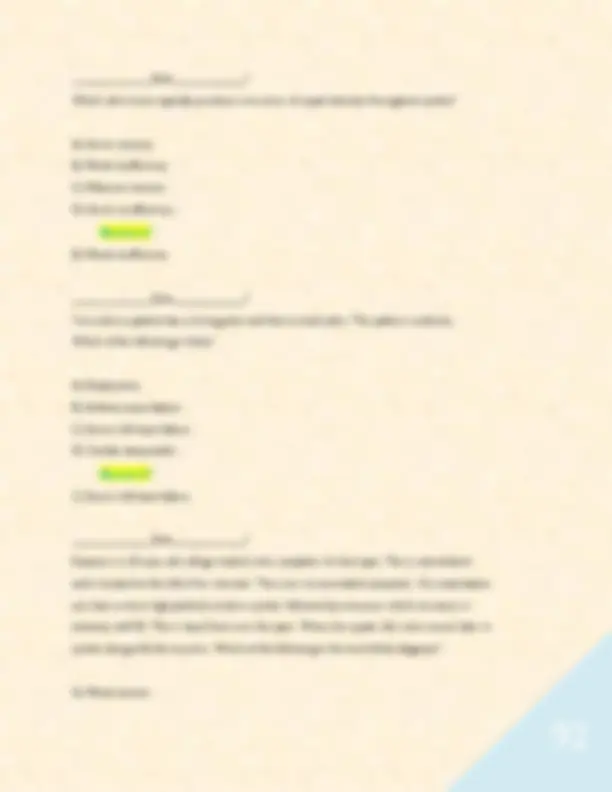
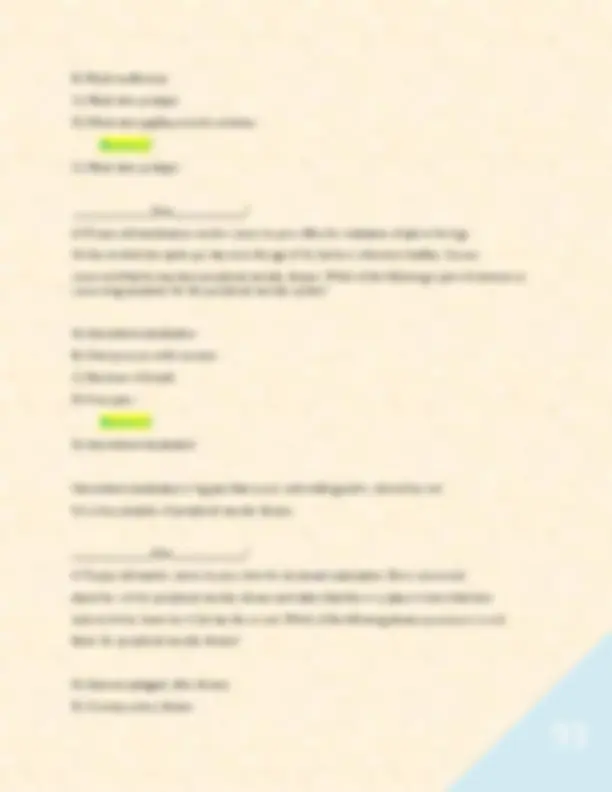
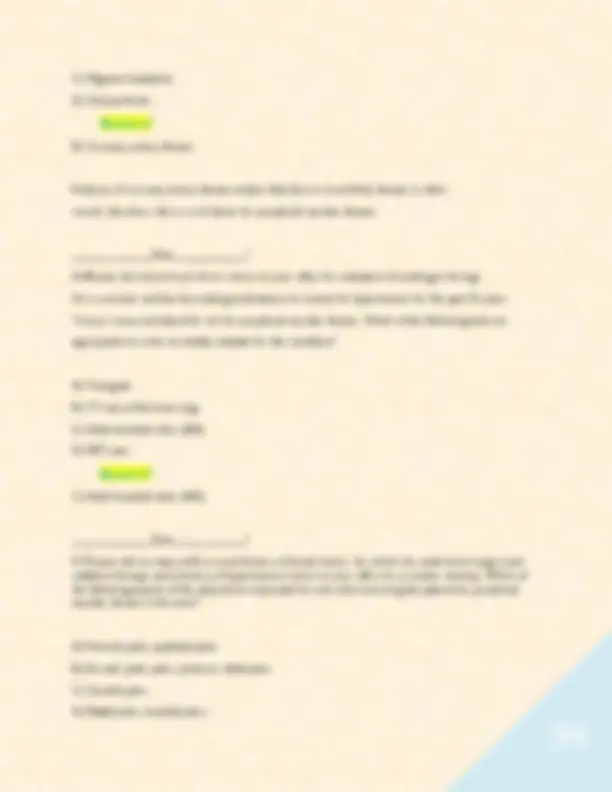
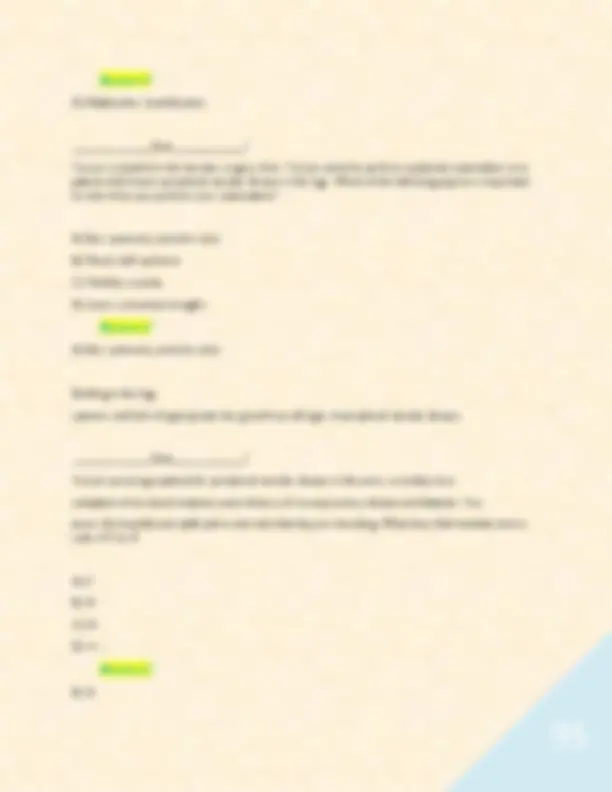
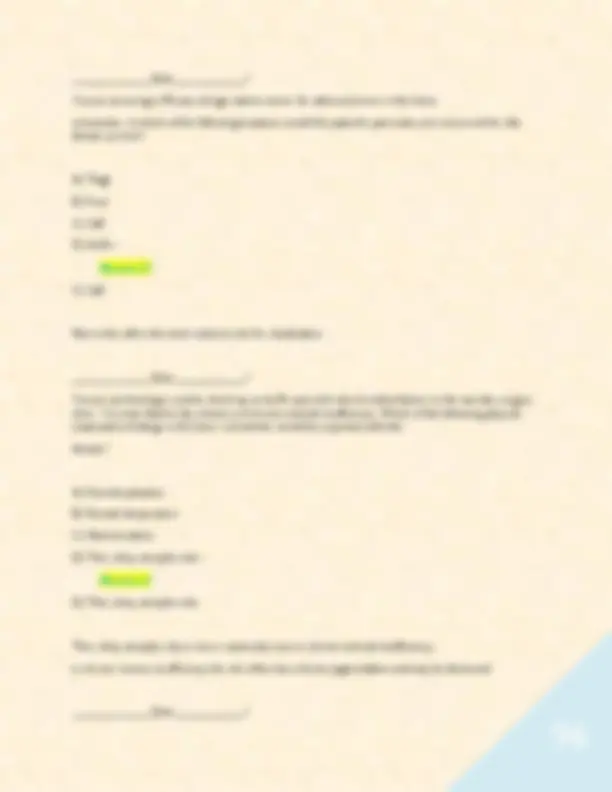
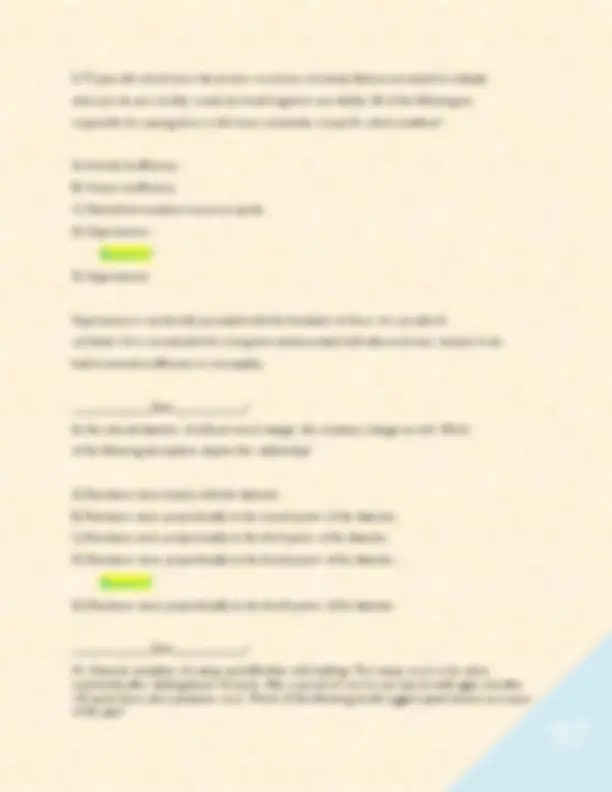
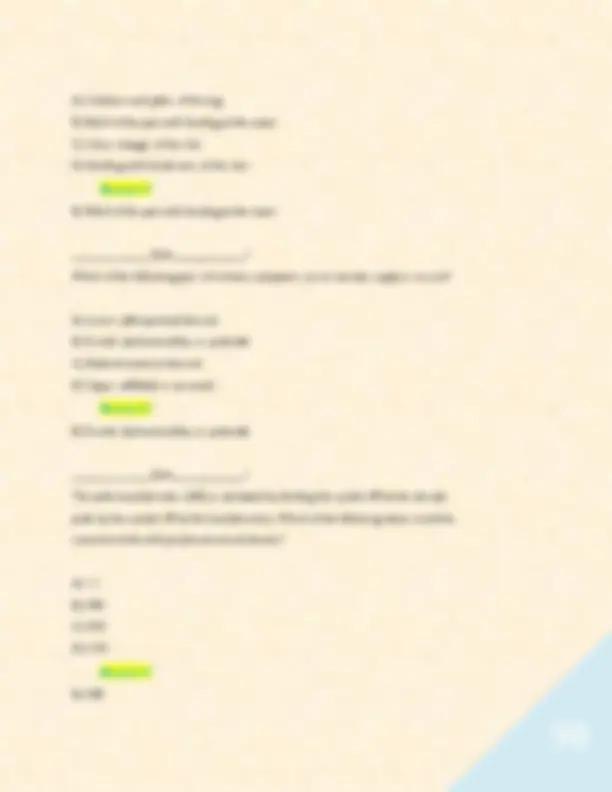
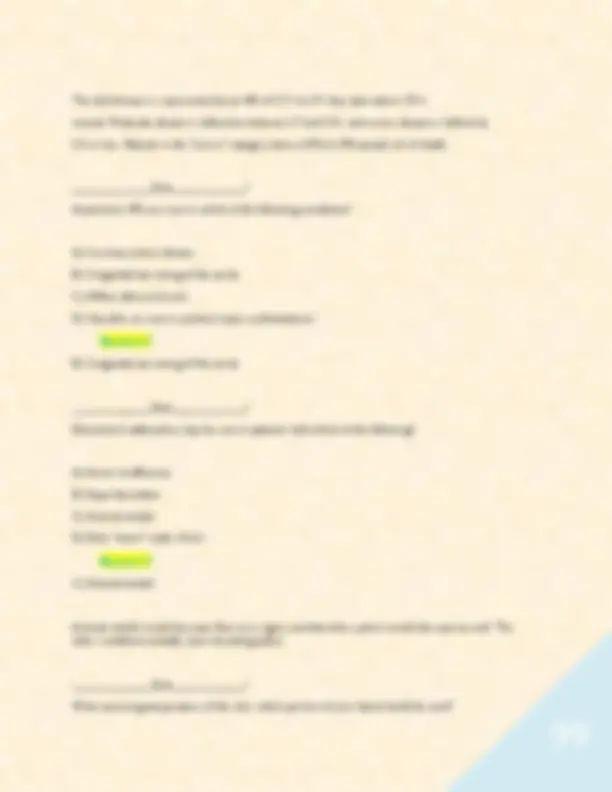
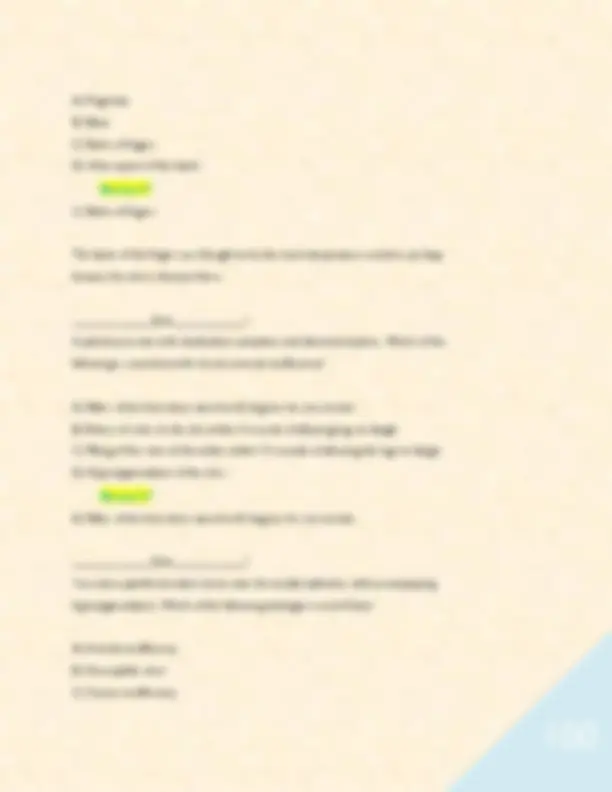


Study with the several resources on Docsity

Earn points by helping other students or get them with a premium plan


Prepare for your exams
Study with the several resources on Docsity

Earn points to download
Earn points by helping other students or get them with a premium plan
Community
Ask the community for help and clear up your study doubts
Discover the best universities in your country according to Docsity users
Free resources
Download our free guides on studying techniques, anxiety management strategies, and thesis advice from Docsity tutors
NR509/ Bates Test Bank Q-BANK– Midterm / Actual Test Questions with Detailed Verified Answers & Rationales (Already Graded A+) Terms in this set (251) _____________Quiz____________? A patient presents for evaluation of a sharp, aching chest pain which increases with breathing. Which anatomic area would you localize the symptom to? A) Musculoskeletal B) Reproductive C) Urinary D) Endocrine - Answer✓✓ A) Musculoskeletal Chest pain may be due to a musculoskeletal condition, such as costochondritis or intercostal muscle cramp. This would be worsened by motion of the chest wall. Pleuritic chest pain is also a sharp chest pain which increases with a deep breath. This type of pain can occur with inflammation of the pleura from pneumonia or other conditions and pulmonary embolus. _____________Quiz____________? A patient comes to the emergency room for evaluation of shortness of breath. To which anatomic region would you assign the symptom? A) Reproductive B) Urinary C) Cardia
Typology: Exams
1 / 132

This page cannot be seen from the preview
Don't miss anything!





























































































Terms in this set (251) _____________Quiz____________? A patient presents for evaluation of a sharp, aching chest pain which increases with breathing. Which anatomic area would you localize the symptom to? A) Musculoskeletal B) Reproductive C) Urinary D) Endocrine -
A) Musculoskeletal Chest pain may be due to a musculoskeletal condition, such as costochondritis or intercostal muscle cramp. This would be worsened by motion of the chest wall. Pleuritic chest pain is also a sharp chest pain which increases with a deep breath. This type of pain can occur with inflammation of the pleura from pneumonia or other conditions and pulmonary embolus. _____________Quiz____________? A patient comes to the emergency room for evaluation of shortness of breath. To which anatomic region would you assign the symptom?
A) Reproductive B) Urinary C) Cardiac D) Hematologic -
C) Cardiac Cardiac disorders such as congestive heart failure are the most likely on this list to result in shortness of breath. There are cases within the other categories which may also result in shortness of breath, such as anemia in the hematologic category, pregnancy in the reproductive category, or sepsis with UTI in the urinary category. _____________Quiz____________? A patient presents for evaluation of a cough. Which of the following anatomic regions can be responsible for a cough? A) Ophthalmologic B) Auditory C) Cardiac D) Endocrine -
C) Cardiac The cardiac system can cause a cough if the patient has congestive heart failure. This results in fluid buildup in the lungs, which in turn can cause a cough that produces pink, frothy sputum. A foreign body in the ear may also cause a cough by stimulating Arnold's branch of the vagus nerve, but this is less likely to be seen clinically than heart failure. _____________Quiz____________? A 22-year-old advertising copywriter presents for evaluation of joint pain. The pain is new,
The description is most consistent with degenerative arthritis in the neck. The patient has had intermittent symptoms and the questions asked to elicit pertinent negative and positive findings are negative for infectious, traumatic, or neoplastic disease. _____________Quiz____________? A 15-year-old high school sophomore comes to the clinic for evaluation of a 3-week history of sneezing; itchy, watery eyes; clear nasal discharge; ear pain; and nonproductive cough. Which is the most likely pathologic process? A) Infection B) Inflammation C) Allergic D) Vascular -
C) Allergic This description is most consistent with allergic rhinitis. _____________Quiz____________? A 19-year old-college student presents to the emergency room with fever, headache, and neck pain/stiffness. She is concerned about the possibility of meningococcal meningitis. Several of her dorm mates have been vaccinated, but she hasn't been. Which of the following physical examination descriptions is most consistent with meningitis? A) Head is normocephalic and atraumatic, fundi with sharp discs, neck supple with full range of motion B) Head is normocephalic and atraumatic, fundi with sharp discs, neck with paraspinous muscle spasm and limited range of motion to the right C) Head is normocephalic and atraumatic, fundi with blurred disc margins, neck tender to palpation, unable to perform range of motion
D) Head is normocephalic and atraumatic, fundi with blurred disc margins, neck supple with full range of motion -
C) Head is normocephalic and atraumatic, fundi with blurred disc margins, neck tender to palpation, unable to perform range of motion Blurred disc margins are consistent with papilledema, and neck tenderness and lack of range of motion are consistent with neck stiffness, which in this scenario is likely to be caused by meningeal inflammation. Kernig's and Brudzinski's signs are also helpful in testing for meningeal irritation on exam. _____________Quiz____________? A 37-year-old nurse comes for evaluation of colicky right upper quadrant abdominal pain. The pain is associated with nausea and vomiting and occurs 1 to 2 hours after eating greasy foods. Which one of the following physical examination descriptions would be most consistent with the diagnosis of cholecystitis? A) Abdomen is soft, nontender, and nondistended, without hepatosplenomegaly or masses. B) Abdomen is soft and tender to palpation in the right lower quadrant, without rebound or guarding. C) Abdomen is soft and tender to palpation in the right upper quadrant with inspiration, to the point of stopping inspiration, and there is no rebound or guarding. D) Abdomen is soft and tender to palpation in the mid-epigastric area, without rebound or guarding. -
C) Abdomen is soft and tender to palpation in the right upper quadrant with inspiration, to the point of stopping inspiration, and there is no rebound or guarding. In cholecystitis, the pain, which originates from the gallbladder, is located in the right upper quadrant. Severity of pain with inspiration that is sufficient to stop further inhalation is also known as Murphy's sign, which, if present, is further indicative of inflammation of the gallbladder.
_____________Quiz____________? Steve has just seen a 5-year-old girl who wheezes when exposed to cats. The patient's family history is positive for asthma. You think the child most likely has asthma. What have you just accomplished? A) You have tested your hypothesis. B) You have developed a plan. C) You have established a working diagnosis. D) You have created a hypothesis. -
D) You have created a hypothesis. As you go through a history and examination, you will start to generate ideas to explain the patient's symptoms. It is best to keep an open mind and make as many hypotheses as you can, to avoid missing a possibility. A common mistake is to latch onto one idea too early. _____________Quiz____________? Ms. Washington is a 67-year-old who had a heart attack last month. Now she complains of shortness of breath and not being able to sleep in a flat position (orthopnea). On examination you note increased jugular venous pressure, an S3 gallop, crackles low in the lung fields, and swollen ankles (edema). This is an example of a: A) Pathophysiologic problem B) Psychopathologic problem -
A) Pathophysiologic problem This is an example of a pathophysiologic problem because Ms. Washington's symptoms are consistent with a pathophysiologic process. The heart attack reduced the ability of her heart to handle her volume status and subsequently produced the many features of congestive heart failure. _____________Quiz____________?
On the way to see your next patient, you glance at the calendar and make a mental note to buy a Mother's Day card. Your patient is Ms. Hernandez, a 76-year-old widow who lost her husband in May, two years ago. She comes in today with a headaches, abdominal pain, and general malaise. This happened once before, about a year ago, according to your detailed office notes. You have done a thorough evaluation but are unable to arrive at a consistent picture to tie these symptoms together. This is an example of a: A) Pathophysiologic problem B) Psychopathologic problem -
B) Psychopathologic problem It is not uncommon for patients to experience psychopathologic symptoms around the anniversary of a traumatic event. The time of year and the lack of an obvious connection between Ms. Hernandez's symptoms would make you consider this as a possibility. You will note that although this might have been an early consideration in your hypothesis generation, it is key to convince yourself that there is not a physiologic explanation for these symptoms, by performing a careful history and examination. _____________Quiz____________? Mr. Larson is a 42-year-old widowed father of two children, ages 4 and 11. He works in a sales office to support his family. Recently he has injured his back and you are thinking he would benefit from physical therapy, three times a week, for an hour per session. What would be your next step? A) Write the physical therapy prescription. B) Have your office staff explain directions to the physical therapy center. C) Discuss the plan with Mr. Larson. D) Tell Mr. Larson that he will be going to physical therapy three times a week. -
B) Use this test when you have a higher suspicion for a certain correlating condition. C) Continue using the test, perhaps doing less laboratory work and diagnostics. D) Omit this test from future examinations. -
C) Continue using the test, perhaps doing less laboratory work and diagnostics. This is an example of a specific test that lacks sensitivity. With this scenario, when you finally find a positive, you might be very certain that a given condition is present. We generally develop our examinations to fit our clinical experiences. Sensitive tests are performed routinely on the screening examination, while specific tests are usually saved for the detailed or "branched" examinations. Branched examinations are further maneuvers we can perform to investigate positive findings on our screening examinations. Save this type of maneuver to confirm your hypothesis. _____________Quiz____________? You have recently returned from a medical missions trip to sub-Saharan Africa, where you learned a great deal about malaria. You decide to use some of the same questions and maneuvers in your "routine" when examining patients in the midwestern United States. You are disappointed to find that despite getting some positive answers and findings, on further workup, none of your patients has malaria except one, who recently emigrated from Ghana. How should you next approach these questions and maneuvers? A) Continue asking these questions in a more selective way. B) Stop asking these questions, because they are low yield. C) Question the validity of the questions. D) Ask these questions of all your patients. -
A) Continue asking these questions in a more selective way. The predictive value of a positive finding depends upon the prevalence of a given
disease in a population. The prevalence of malaria in the Midwest is almost zero, except in people immigrating from areas of high prevalence. You will waste time and resources applying these questions and maneuvers to all patients. It would be wise to continue applying what you learned to those who are from areas of high prevalence of a given disease. You will learn to tailor your examination to the population you are serving. _____________Quiz____________? For which of the following patients would a comprehensive health history be appropriate? A) A new patient with the chief complaint of "I sprained my ankle". B) An established patient with the chief complaint of "I have an upper respiratory infection". C) A new patient with the chief complaint of "I am here to establish care". D) A new patient with the chief complaint of "I cut my hand". -
C) A new patient with the chief complaint of "I am here to establish care". This patient is here to establish care, and because she is new to you, a comprehensive health history is appropriate. _____________Quiz____________? The components of the health history include all of the following except which one? A) Review of systems B) Thorax and lungs C) Present illness D) Personal and social items -
B) Thorax and lungs
pain for 1 week. The pain lasts for 30 minutes at a time; it comes and goes. The severity is 7 to 9 on a scale of 1 to 10. It is accompanied by nausea and vomiting. It is located in the mid-epigastric area." Which of these categories does it belong to? A) Chief complaint B) Present illness C) Personal and social history D) Review of systems -
B) Present illness This information describes the problem of abdominal pain, which is the present illness. The interviewer has obtained the location, timing, severity, and associated manifestations of the pain. The interviewer will still need to obtain information concerning the quality of the pain, the setting in which it occurred, and the factors that aggravate and alleviate the pain. _____________Quiz____________? The following information is recorded in the health history: "The patient completed 8th grade. He currently lives with his wife and two children. He works on old cars on the weekend. He works in a glass factory during the week." Which category does it belong to? A) Chief complaint B) Present illness C) Personal and social history D) Review of systems -
C) Personal and social history.
Personal and social history information includes educational level, family of origin, current household status, personal interests, employment, religious beliefs, military history, and lifestyle (including diet and exercise habits; use of alcohol, tobacco, and/or drugs; and sexual preferences and history). _____________Quiz____________? The following information is recorded in the health history: "I feel really tired." Which category does it belong to? A) Chief complaint B) Present illness C) Personal and social history D) Review of systems -
A) Chief complaint The chief complaint is an attempt to quote the patient's own words. It is brief, like a headline, and further details should be sought in the present illness section. _____________Quiz____________? The following information is recorded in the health history: "Patient denies chest pain, palpitations, orthopnea, and paroxysmal nocturnal dyspnea." Which category does it belong to? A) Chief complaint B) Present illness C) Personal and social history D) Review of systems -
The adult illnesses category is reserved for chronic illnesses, significant hospitalizations, significant injuries, and significant procedures. A stent is a major procedure but does not involve a surgery. _____________Quiz____________? The following information is best placed in which category? "The patient was treated for an asthma exacerbation in the hospital last year; the patient has never been intubated." A) Adult illnesses B) Surgeries C) Obstetrics/gynecology D) Psychiatric -
A) Adult illnesses This is information about a significant hospitalization and should be placed in the adult illnesses section. If the patient is being seen for an asthma exacerbation, you may consider placing this info in the present illness section, because it relates to the chief complaint at that visit. _____________Quiz____________? You are running late after your quarterly quality improvement meeting at the hospital and have just gotten paged from the nurses' station because a family member of one of your patients wants to talk with you about that patient's care. You have clinic this afternoon and are double-booked for the first appointment time; three other patients also have arrived and are sitting in the waiting room. Which of the following demeanors is a behavior consistent with skilled interviewing when you walk into the examination room to speak with your first clinic patient? A) Irritability
B) Impatience C) Boredom D) Calm -
D) Calm The appearance of calmness and patience, even when time is limited, is the hallmark of a skilled interviewer. _____________Quiz____________? Suzanne, a 25 year old, comes to your clinic to establish care. You are the student preparing to go into the examination room to interview her. Which of the following is the most logical sequence for the patient-provider interview? A) Establish the agenda, negotiate a plan, establish rapport, and invite the patient's story. B) Invite the patient's story, negotiate a plan, establish the agenda, and establish rapport. C) Greet the patient, establish rapport, invite the patient's story, establish the agenda, expand and clarify the patient's story, and negotiate a plan. D) Negotiate a plan, establish an agenda, invite the patient's story, and establish rapport. -
C) Greet the patient, establish rapport, invite the patient's story, establish the agenda, expand and clarify the patient's story, and negotiate a plan. This is the most productive sequence for the interview. Greeting patients and establishing rapport allows them to feel more comfortable before "inviting" them to relate their story. After hearing the patient's story, together you establish the agenda regarding the most important items to expand upon. At the end, together you negotiate the plan of diagnosis and treatment. _____________Quiz____________? Alexandra is a 28-year-old editor who presents to the clinic with abdominal pain. The pain is
C) Timing D) Associated manifestations -
A) Severity The severity of the symptom was not recorded by the interviewer, so we have no understanding as to how bad the symptom is for this patient. This allows the comparison of pain intensity before and after an intervention. _____________Quiz____________? You are interviewing an elderly woman in the ambulatory setting and trying to get more information about her urinary symptoms. Which of the following techniques is not a component of adaptive questioning? A) Directed questioning: starting with the general and proceeding to the specific in a manner that does not make the patient give a yes/no answer B) Reassuring the patient that the urinary symptoms are benign and that she doesn't need to worry about it being a sign of cancer C) Offering the patient multiple choices in order to clarify the character of the urinary symptoms that she is experiencing D) Asking her to tell you exactly what she means when she states that she has a urinary tract infection -
B) Reassuring the patient that the urinary symptoms are benign and that she doesn't need to worry about it being a sign of cancer Reassurance is not part of clarifying the patient's story; it is part of establishing rapport and empathizing with the patient. _____________Quiz____________?
Mr. W. is a 51-year-old auto mechanic who comes to the emergency room wanting to be checked out for the symptom of chest pain. As you listen to him describe his symptom in more detail, you say "Go on," and later, "Mm-hmmm." This is an example of which of the following skilled interviewing techniques? A) Echoing B) Nonverbal communication C) Facilitation D) Empathic response -
C) Facilitation This is an example of facilitation. Facilitation can be posture, actions, or words that encourage the patient to say more. _____________Quiz____________? Mrs. R. is a 92-year-old retired teacher who comes to your clinic accompanied by her daughter. You ask Mrs. R. why she came to your clinic today. She looks at her daughter and doesn't say anything in response to your question. This is an example of which type of challenging patient? A) Talkative patient B) Angry patient C) Silent patient D) Hearing-impaired patient -
C) Silent patient This is one example of a silent patient. There are many possibilities for this patient's silence: depression, dementia, the manner in which you asked the question, and so on.